Organisational Behaviour: A Case Study of the BBC
VerifiedAdded on 2024/07/01
|22
|4841
|153
AI Summary
This assignment examines the organisational behaviour of the British Broadcasting Corporation (BBC), focusing on the impact of culture, power, and politics on its workforce. It explores how content and process theories of motivation could have been applied to improve team effectiveness and productivity. The assignment also analyzes the different types of teams within the BBC and the barriers to effective performance, drawing on relevant theories such as Tuckman and Jensen's model of team development and Belbin's team roles. Finally, it suggests how the Path-Goal theory of leadership could be used to enhance team performance and productivity.
Contribute Materials
Your contribution can guide someone’s learning journey. Share your
documents today.
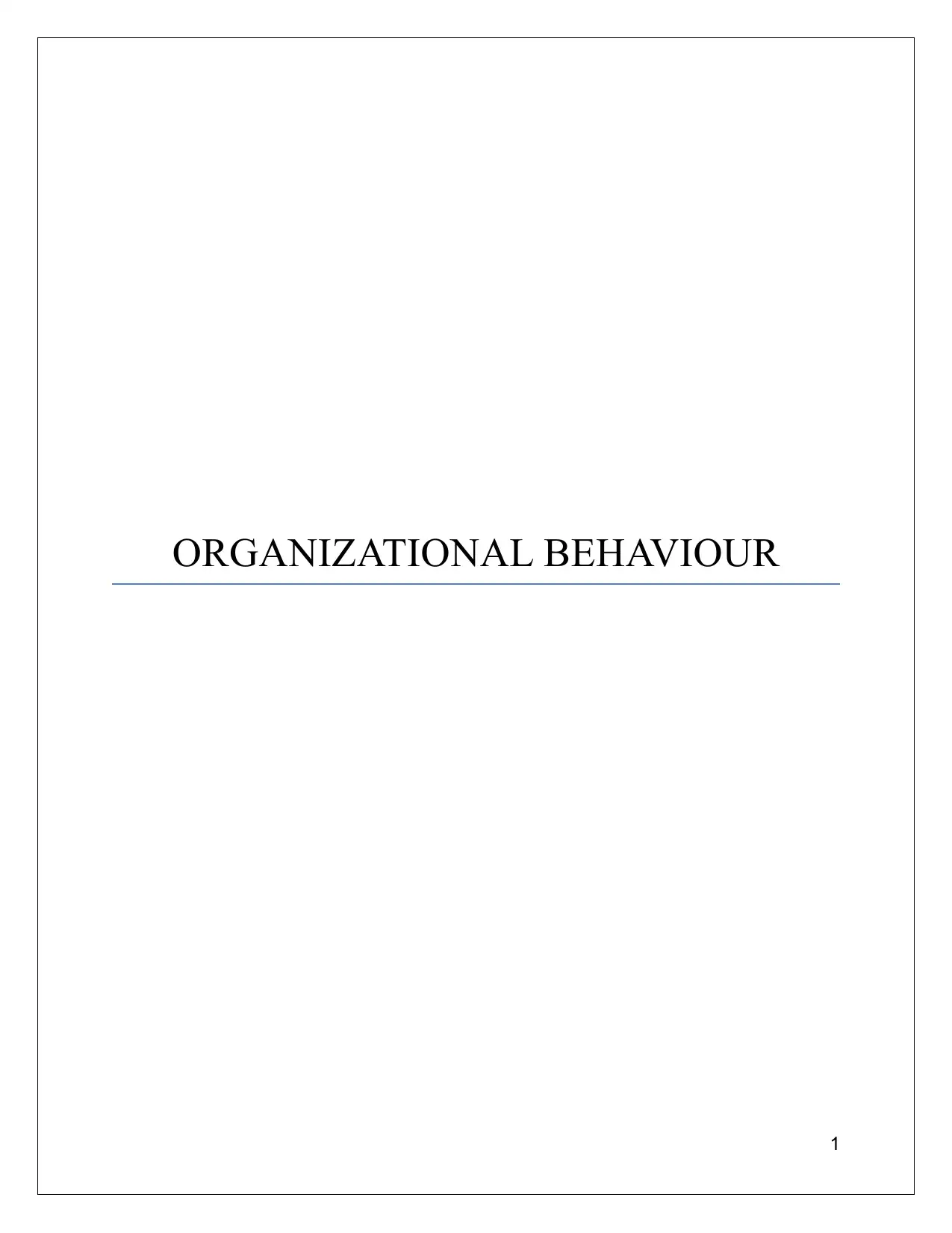
ORGANIZATIONAL BEHAVIOUR
1
1
Secure Best Marks with AI Grader
Need help grading? Try our AI Grader for instant feedback on your assignments.
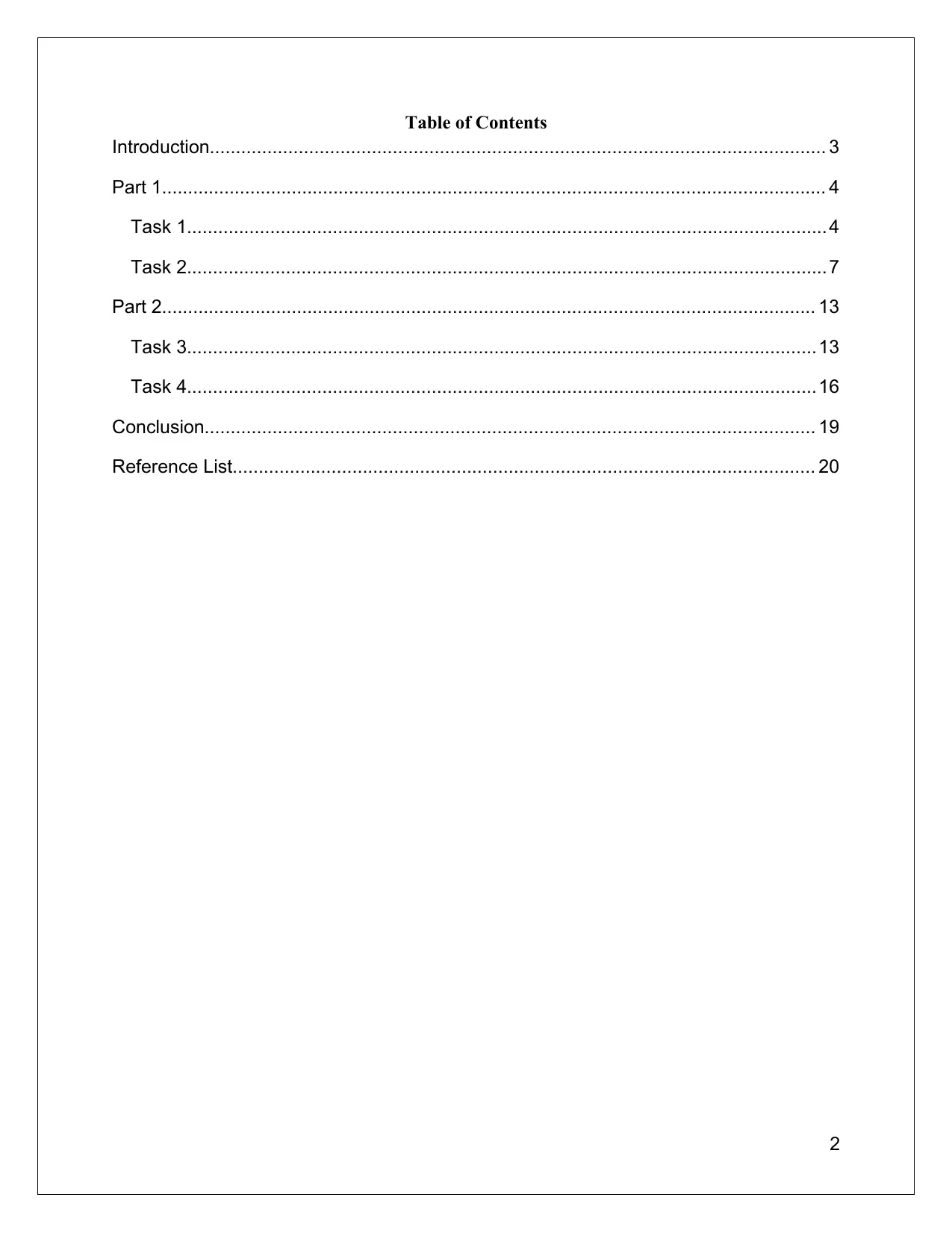
Table of Contents
Introduction...................................................................................................................... 3
Part 1................................................................................................................................ 4
Task 1...........................................................................................................................4
Task 2...........................................................................................................................7
Part 2.............................................................................................................................. 13
Task 3.........................................................................................................................13
Task 4.........................................................................................................................16
Conclusion..................................................................................................................... 19
Reference List................................................................................................................ 20
2
Introduction...................................................................................................................... 3
Part 1................................................................................................................................ 4
Task 1...........................................................................................................................4
Task 2...........................................................................................................................7
Part 2.............................................................................................................................. 13
Task 3.........................................................................................................................13
Task 4.........................................................................................................................16
Conclusion..................................................................................................................... 19
Reference List................................................................................................................ 20
2
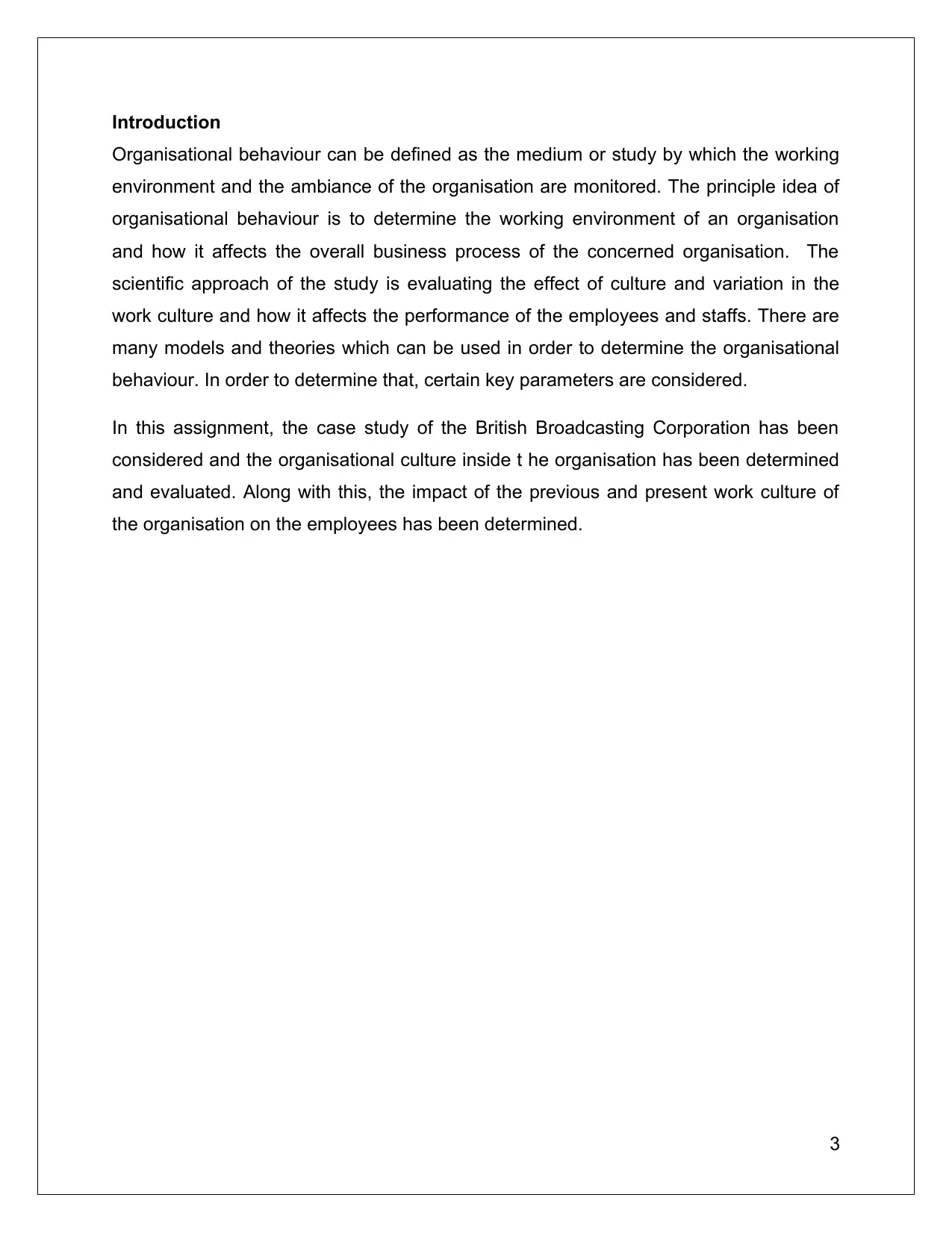
Introduction
Organisational behaviour can be defined as the medium or study by which the working
environment and the ambiance of the organisation are monitored. The principle idea of
organisational behaviour is to determine the working environment of an organisation
and how it affects the overall business process of the concerned organisation. The
scientific approach of the study is evaluating the effect of culture and variation in the
work culture and how it affects the performance of the employees and staffs. There are
many models and theories which can be used in order to determine the organisational
behaviour. In order to determine that, certain key parameters are considered.
In this assignment, the case study of the British Broadcasting Corporation has been
considered and the organisational culture inside t he organisation has been determined
and evaluated. Along with this, the impact of the previous and present work culture of
the organisation on the employees has been determined.
3
Organisational behaviour can be defined as the medium or study by which the working
environment and the ambiance of the organisation are monitored. The principle idea of
organisational behaviour is to determine the working environment of an organisation
and how it affects the overall business process of the concerned organisation. The
scientific approach of the study is evaluating the effect of culture and variation in the
work culture and how it affects the performance of the employees and staffs. There are
many models and theories which can be used in order to determine the organisational
behaviour. In order to determine that, certain key parameters are considered.
In this assignment, the case study of the British Broadcasting Corporation has been
considered and the organisational culture inside t he organisation has been determined
and evaluated. Along with this, the impact of the previous and present work culture of
the organisation on the employees has been determined.
3
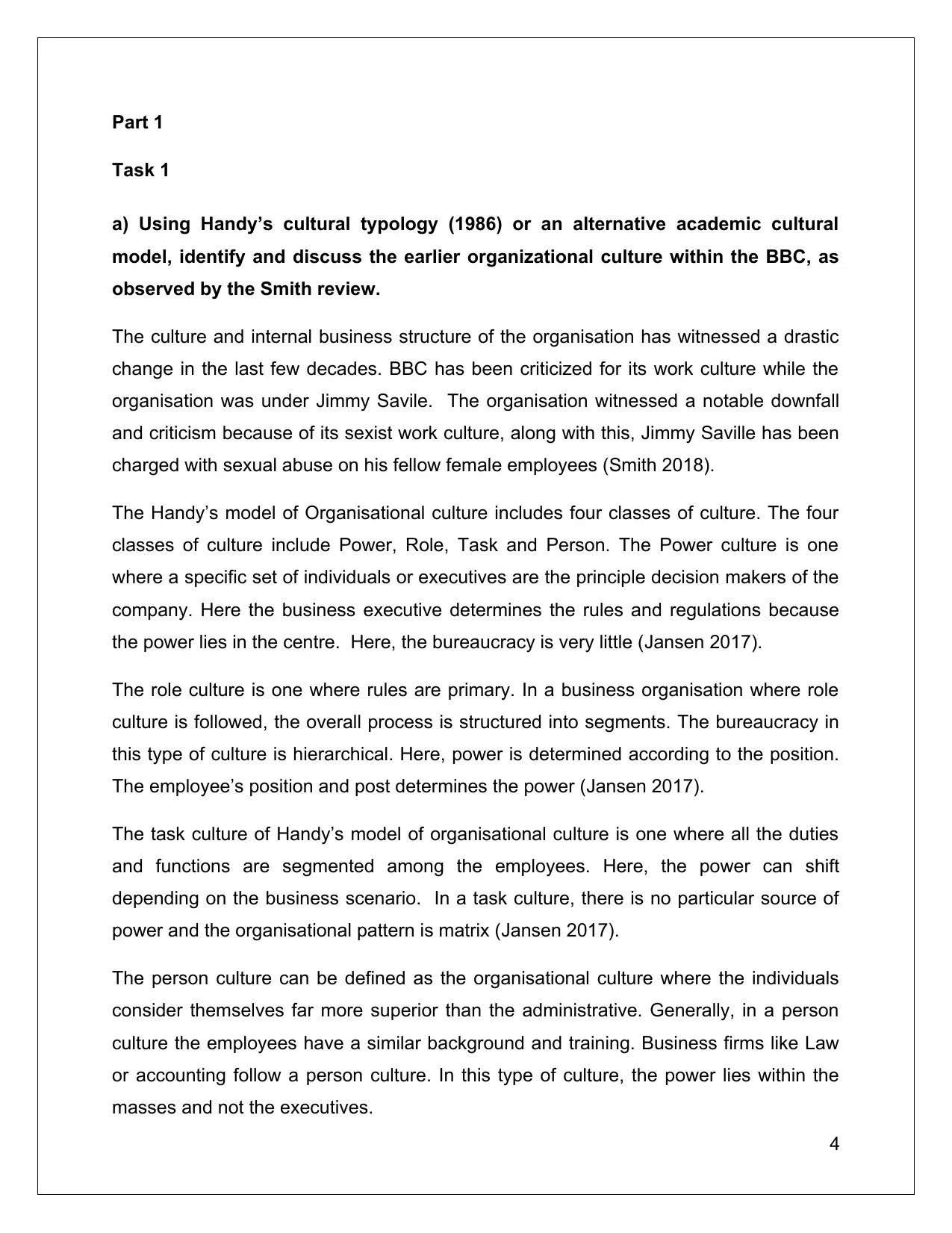
Part 1
Task 1
a) Using Handy’s cultural typology (1986) or an alternative academic cultural
model, identify and discuss the earlier organizational culture within the BBC, as
observed by the Smith review.
The culture and internal business structure of the organisation has witnessed a drastic
change in the last few decades. BBC has been criticized for its work culture while the
organisation was under Jimmy Savile. The organisation witnessed a notable downfall
and criticism because of its sexist work culture, along with this, Jimmy Saville has been
charged with sexual abuse on his fellow female employees (Smith 2018).
The Handy’s model of Organisational culture includes four classes of culture. The four
classes of culture include Power, Role, Task and Person. The Power culture is one
where a specific set of individuals or executives are the principle decision makers of the
company. Here the business executive determines the rules and regulations because
the power lies in the centre. Here, the bureaucracy is very little (Jansen 2017).
The role culture is one where rules are primary. In a business organisation where role
culture is followed, the overall process is structured into segments. The bureaucracy in
this type of culture is hierarchical. Here, power is determined according to the position.
The employee’s position and post determines the power (Jansen 2017).
The task culture of Handy’s model of organisational culture is one where all the duties
and functions are segmented among the employees. Here, the power can shift
depending on the business scenario. In a task culture, there is no particular source of
power and the organisational pattern is matrix (Jansen 2017).
The person culture can be defined as the organisational culture where the individuals
consider themselves far more superior than the administrative. Generally, in a person
culture the employees have a similar background and training. Business firms like Law
or accounting follow a person culture. In this type of culture, the power lies within the
masses and not the executives.
4
Task 1
a) Using Handy’s cultural typology (1986) or an alternative academic cultural
model, identify and discuss the earlier organizational culture within the BBC, as
observed by the Smith review.
The culture and internal business structure of the organisation has witnessed a drastic
change in the last few decades. BBC has been criticized for its work culture while the
organisation was under Jimmy Savile. The organisation witnessed a notable downfall
and criticism because of its sexist work culture, along with this, Jimmy Saville has been
charged with sexual abuse on his fellow female employees (Smith 2018).
The Handy’s model of Organisational culture includes four classes of culture. The four
classes of culture include Power, Role, Task and Person. The Power culture is one
where a specific set of individuals or executives are the principle decision makers of the
company. Here the business executive determines the rules and regulations because
the power lies in the centre. Here, the bureaucracy is very little (Jansen 2017).
The role culture is one where rules are primary. In a business organisation where role
culture is followed, the overall process is structured into segments. The bureaucracy in
this type of culture is hierarchical. Here, power is determined according to the position.
The employee’s position and post determines the power (Jansen 2017).
The task culture of Handy’s model of organisational culture is one where all the duties
and functions are segmented among the employees. Here, the power can shift
depending on the business scenario. In a task culture, there is no particular source of
power and the organisational pattern is matrix (Jansen 2017).
The person culture can be defined as the organisational culture where the individuals
consider themselves far more superior than the administrative. Generally, in a person
culture the employees have a similar background and training. Business firms like Law
or accounting follow a person culture. In this type of culture, the power lies within the
masses and not the executives.
4
Secure Best Marks with AI Grader
Need help grading? Try our AI Grader for instant feedback on your assignments.
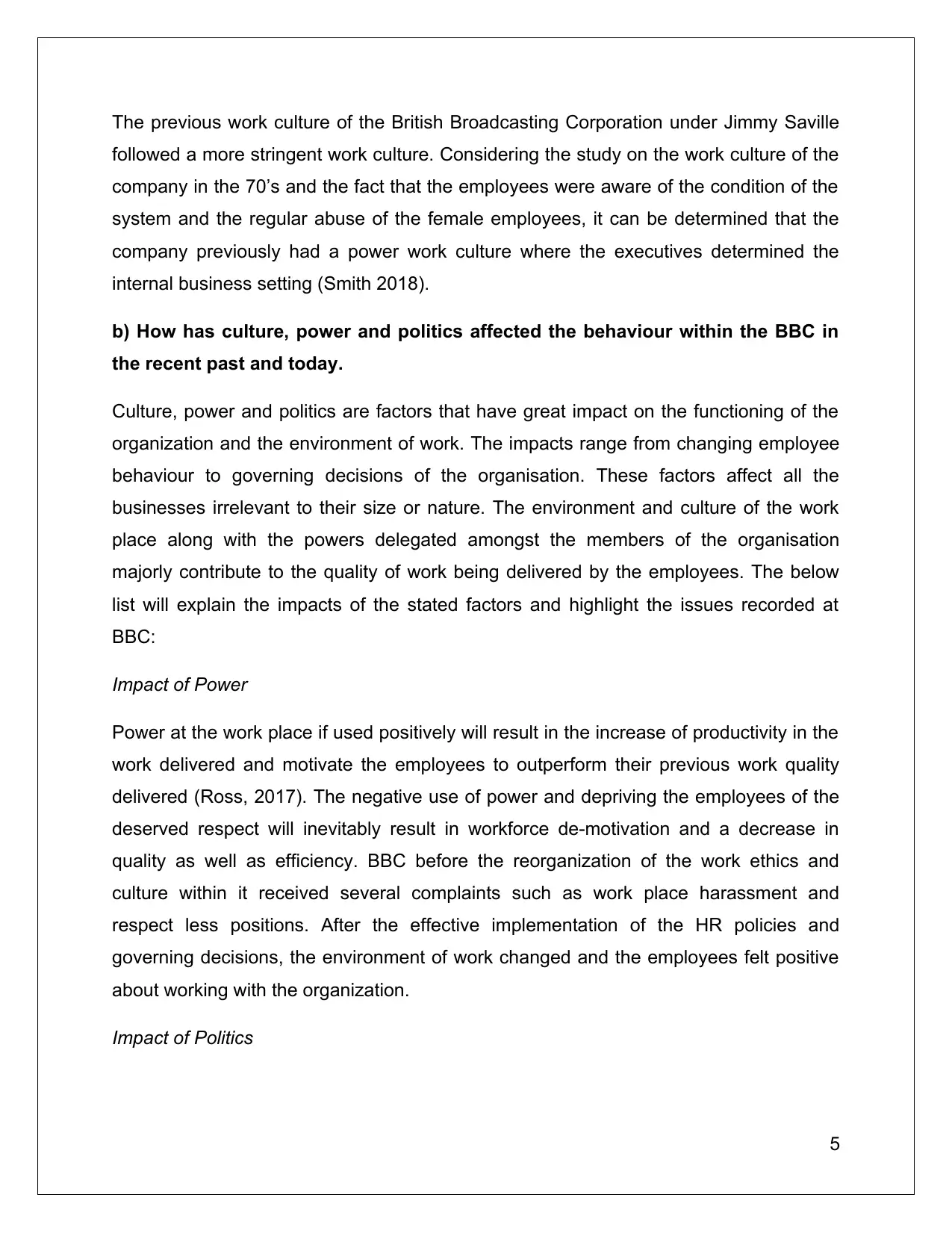
The previous work culture of the British Broadcasting Corporation under Jimmy Saville
followed a more stringent work culture. Considering the study on the work culture of the
company in the 70’s and the fact that the employees were aware of the condition of the
system and the regular abuse of the female employees, it can be determined that the
company previously had a power work culture where the executives determined the
internal business setting (Smith 2018).
b) How has culture, power and politics affected the behaviour within the BBC in
the recent past and today.
Culture, power and politics are factors that have great impact on the functioning of the
organization and the environment of work. The impacts range from changing employee
behaviour to governing decisions of the organisation. These factors affect all the
businesses irrelevant to their size or nature. The environment and culture of the work
place along with the powers delegated amongst the members of the organisation
majorly contribute to the quality of work being delivered by the employees. The below
list will explain the impacts of the stated factors and highlight the issues recorded at
BBC:
Impact of Power
Power at the work place if used positively will result in the increase of productivity in the
work delivered and motivate the employees to outperform their previous work quality
delivered (Ross, 2017). The negative use of power and depriving the employees of the
deserved respect will inevitably result in workforce de-motivation and a decrease in
quality as well as efficiency. BBC before the reorganization of the work ethics and
culture within it received several complaints such as work place harassment and
respect less positions. After the effective implementation of the HR policies and
governing decisions, the environment of work changed and the employees felt positive
about working with the organization.
Impact of Politics
5
followed a more stringent work culture. Considering the study on the work culture of the
company in the 70’s and the fact that the employees were aware of the condition of the
system and the regular abuse of the female employees, it can be determined that the
company previously had a power work culture where the executives determined the
internal business setting (Smith 2018).
b) How has culture, power and politics affected the behaviour within the BBC in
the recent past and today.
Culture, power and politics are factors that have great impact on the functioning of the
organization and the environment of work. The impacts range from changing employee
behaviour to governing decisions of the organisation. These factors affect all the
businesses irrelevant to their size or nature. The environment and culture of the work
place along with the powers delegated amongst the members of the organisation
majorly contribute to the quality of work being delivered by the employees. The below
list will explain the impacts of the stated factors and highlight the issues recorded at
BBC:
Impact of Power
Power at the work place if used positively will result in the increase of productivity in the
work delivered and motivate the employees to outperform their previous work quality
delivered (Ross, 2017). The negative use of power and depriving the employees of the
deserved respect will inevitably result in workforce de-motivation and a decrease in
quality as well as efficiency. BBC before the reorganization of the work ethics and
culture within it received several complaints such as work place harassment and
respect less positions. After the effective implementation of the HR policies and
governing decisions, the environment of work changed and the employees felt positive
about working with the organization.
Impact of Politics
5
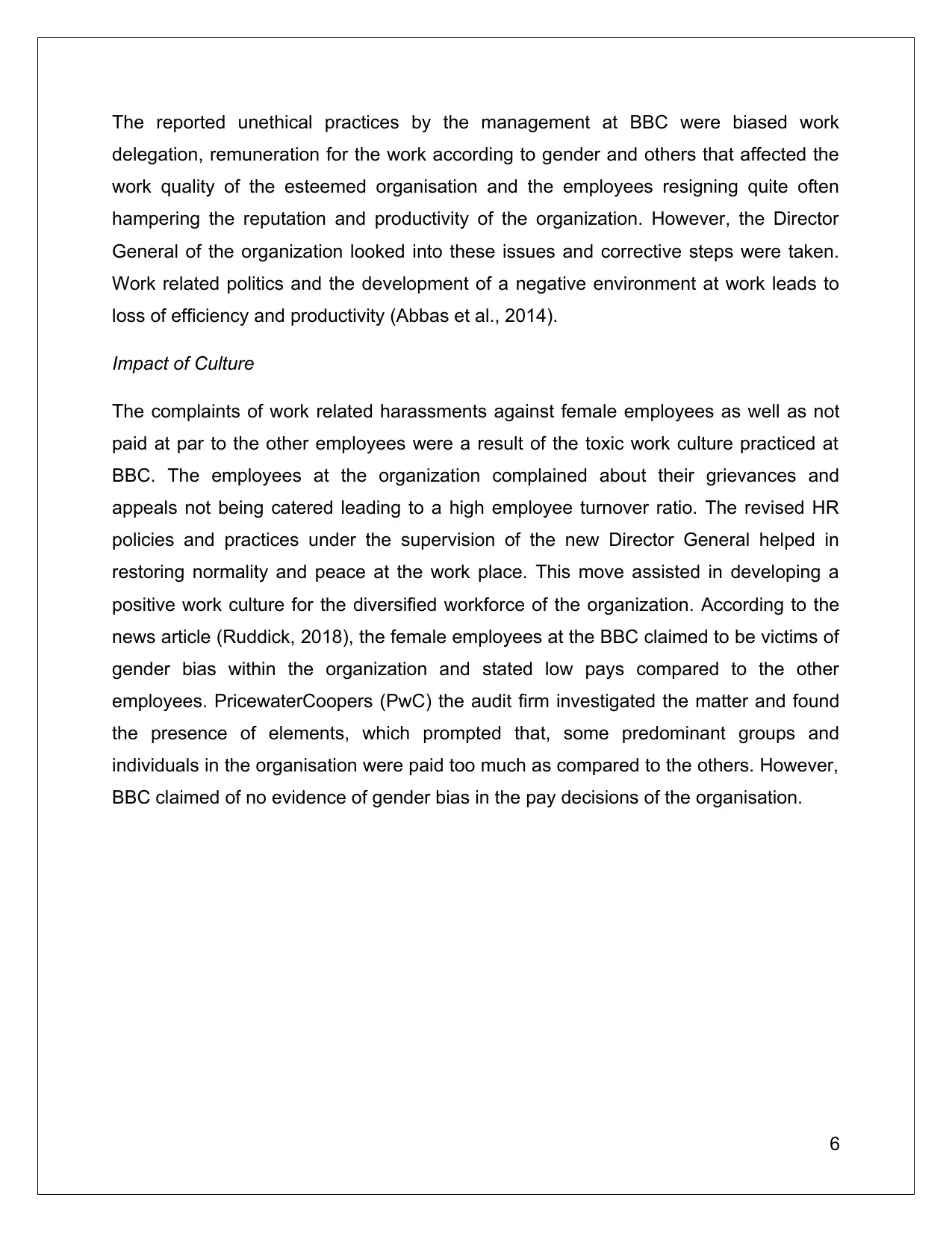
The reported unethical practices by the management at BBC were biased work
delegation, remuneration for the work according to gender and others that affected the
work quality of the esteemed organisation and the employees resigning quite often
hampering the reputation and productivity of the organization. However, the Director
General of the organization looked into these issues and corrective steps were taken.
Work related politics and the development of a negative environment at work leads to
loss of efficiency and productivity (Abbas et al., 2014).
Impact of Culture
The complaints of work related harassments against female employees as well as not
paid at par to the other employees were a result of the toxic work culture practiced at
BBC. The employees at the organization complained about their grievances and
appeals not being catered leading to a high employee turnover ratio. The revised HR
policies and practices under the supervision of the new Director General helped in
restoring normality and peace at the work place. This move assisted in developing a
positive work culture for the diversified workforce of the organization. According to the
news article (Ruddick, 2018), the female employees at the BBC claimed to be victims of
gender bias within the organization and stated low pays compared to the other
employees. PricewaterCoopers (PwC) the audit firm investigated the matter and found
the presence of elements, which prompted that, some predominant groups and
individuals in the organisation were paid too much as compared to the others. However,
BBC claimed of no evidence of gender bias in the pay decisions of the organisation.
6
delegation, remuneration for the work according to gender and others that affected the
work quality of the esteemed organisation and the employees resigning quite often
hampering the reputation and productivity of the organization. However, the Director
General of the organization looked into these issues and corrective steps were taken.
Work related politics and the development of a negative environment at work leads to
loss of efficiency and productivity (Abbas et al., 2014).
Impact of Culture
The complaints of work related harassments against female employees as well as not
paid at par to the other employees were a result of the toxic work culture practiced at
BBC. The employees at the organization complained about their grievances and
appeals not being catered leading to a high employee turnover ratio. The revised HR
policies and practices under the supervision of the new Director General helped in
restoring normality and peace at the work place. This move assisted in developing a
positive work culture for the diversified workforce of the organization. According to the
news article (Ruddick, 2018), the female employees at the BBC claimed to be victims of
gender bias within the organization and stated low pays compared to the other
employees. PricewaterCoopers (PwC) the audit firm investigated the matter and found
the presence of elements, which prompted that, some predominant groups and
individuals in the organisation were paid too much as compared to the others. However,
BBC claimed of no evidence of gender bias in the pay decisions of the organisation.
6
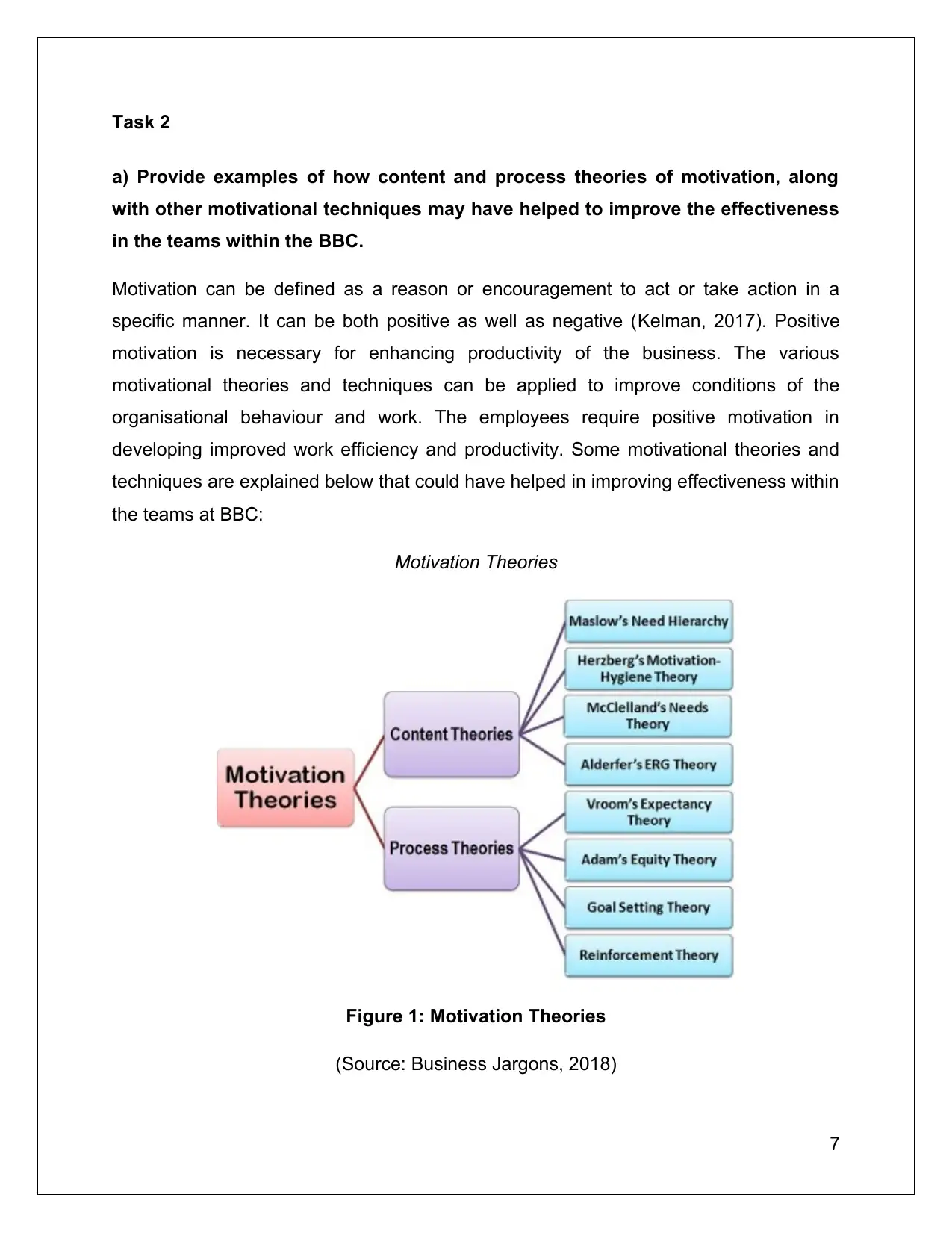
Task 2
a) Provide examples of how content and process theories of motivation, along
with other motivational techniques may have helped to improve the effectiveness
in the teams within the BBC.
Motivation can be defined as a reason or encouragement to act or take action in a
specific manner. It can be both positive as well as negative (Kelman, 2017). Positive
motivation is necessary for enhancing productivity of the business. The various
motivational theories and techniques can be applied to improve conditions of the
organisational behaviour and work. The employees require positive motivation in
developing improved work efficiency and productivity. Some motivational theories and
techniques are explained below that could have helped in improving effectiveness within
the teams at BBC:
Motivation Theories
Figure 1: Motivation Theories
(Source: Business Jargons, 2018)
7
a) Provide examples of how content and process theories of motivation, along
with other motivational techniques may have helped to improve the effectiveness
in the teams within the BBC.
Motivation can be defined as a reason or encouragement to act or take action in a
specific manner. It can be both positive as well as negative (Kelman, 2017). Positive
motivation is necessary for enhancing productivity of the business. The various
motivational theories and techniques can be applied to improve conditions of the
organisational behaviour and work. The employees require positive motivation in
developing improved work efficiency and productivity. Some motivational theories and
techniques are explained below that could have helped in improving effectiveness within
the teams at BBC:
Motivation Theories
Figure 1: Motivation Theories
(Source: Business Jargons, 2018)
7
Paraphrase This Document
Need a fresh take? Get an instant paraphrase of this document with our AI Paraphraser
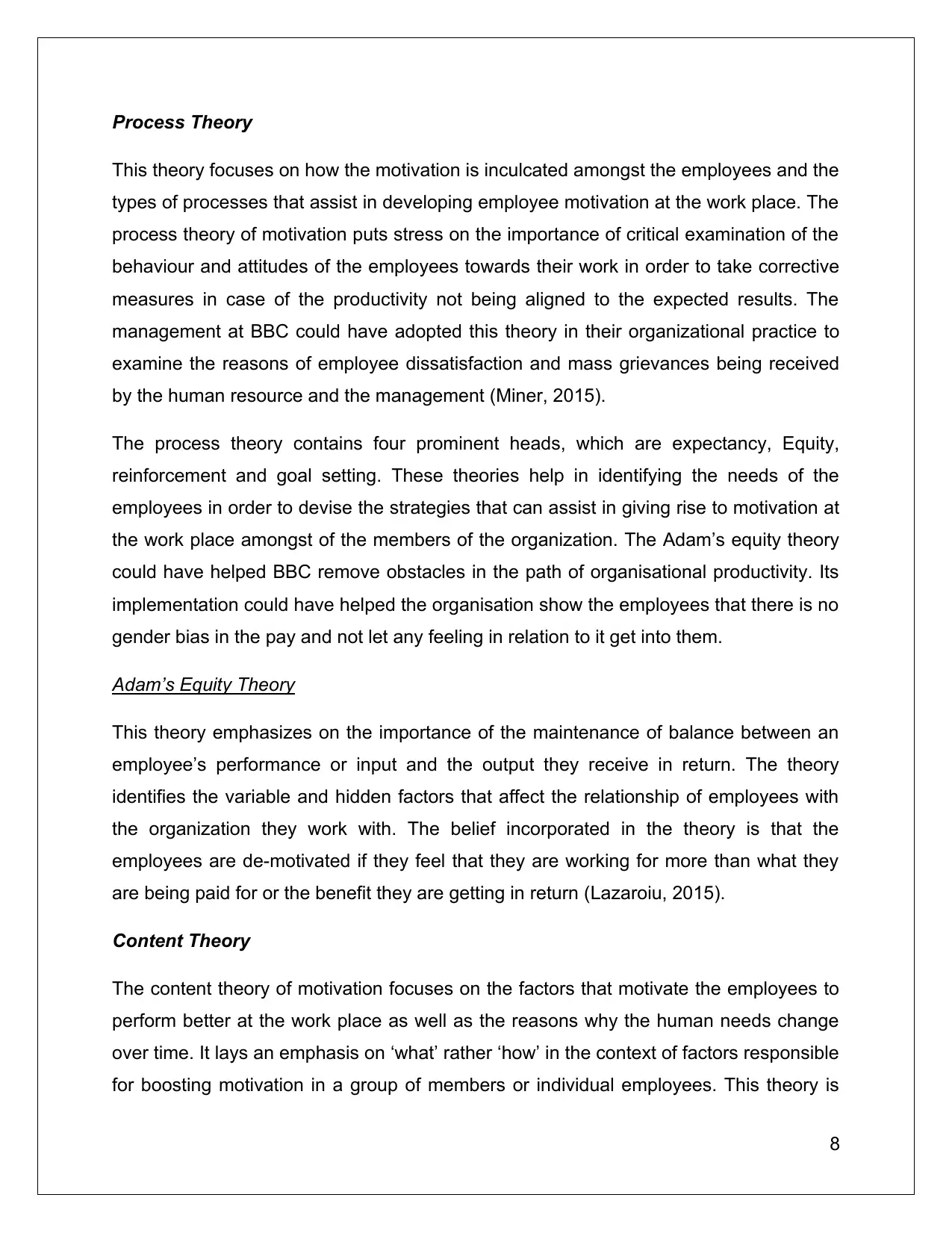
Process Theory
This theory focuses on how the motivation is inculcated amongst the employees and the
types of processes that assist in developing employee motivation at the work place. The
process theory of motivation puts stress on the importance of critical examination of the
behaviour and attitudes of the employees towards their work in order to take corrective
measures in case of the productivity not being aligned to the expected results. The
management at BBC could have adopted this theory in their organizational practice to
examine the reasons of employee dissatisfaction and mass grievances being received
by the human resource and the management (Miner, 2015).
The process theory contains four prominent heads, which are expectancy, Equity,
reinforcement and goal setting. These theories help in identifying the needs of the
employees in order to devise the strategies that can assist in giving rise to motivation at
the work place amongst of the members of the organization. The Adam’s equity theory
could have helped BBC remove obstacles in the path of organisational productivity. Its
implementation could have helped the organisation show the employees that there is no
gender bias in the pay and not let any feeling in relation to it get into them.
Adam’s Equity Theory
This theory emphasizes on the importance of the maintenance of balance between an
employee’s performance or input and the output they receive in return. The theory
identifies the variable and hidden factors that affect the relationship of employees with
the organization they work with. The belief incorporated in the theory is that the
employees are de-motivated if they feel that they are working for more than what they
are being paid for or the benefit they are getting in return (Lazaroiu, 2015).
Content Theory
The content theory of motivation focuses on the factors that motivate the employees to
perform better at the work place as well as the reasons why the human needs change
over time. It lays an emphasis on ‘what’ rather ‘how’ in the context of factors responsible
for boosting motivation in a group of members or individual employees. This theory is
8
This theory focuses on how the motivation is inculcated amongst the employees and the
types of processes that assist in developing employee motivation at the work place. The
process theory of motivation puts stress on the importance of critical examination of the
behaviour and attitudes of the employees towards their work in order to take corrective
measures in case of the productivity not being aligned to the expected results. The
management at BBC could have adopted this theory in their organizational practice to
examine the reasons of employee dissatisfaction and mass grievances being received
by the human resource and the management (Miner, 2015).
The process theory contains four prominent heads, which are expectancy, Equity,
reinforcement and goal setting. These theories help in identifying the needs of the
employees in order to devise the strategies that can assist in giving rise to motivation at
the work place amongst of the members of the organization. The Adam’s equity theory
could have helped BBC remove obstacles in the path of organisational productivity. Its
implementation could have helped the organisation show the employees that there is no
gender bias in the pay and not let any feeling in relation to it get into them.
Adam’s Equity Theory
This theory emphasizes on the importance of the maintenance of balance between an
employee’s performance or input and the output they receive in return. The theory
identifies the variable and hidden factors that affect the relationship of employees with
the organization they work with. The belief incorporated in the theory is that the
employees are de-motivated if they feel that they are working for more than what they
are being paid for or the benefit they are getting in return (Lazaroiu, 2015).
Content Theory
The content theory of motivation focuses on the factors that motivate the employees to
perform better at the work place as well as the reasons why the human needs change
over time. It lays an emphasis on ‘what’ rather ‘how’ in the context of factors responsible
for boosting motivation in a group of members or individual employees. This theory is
8
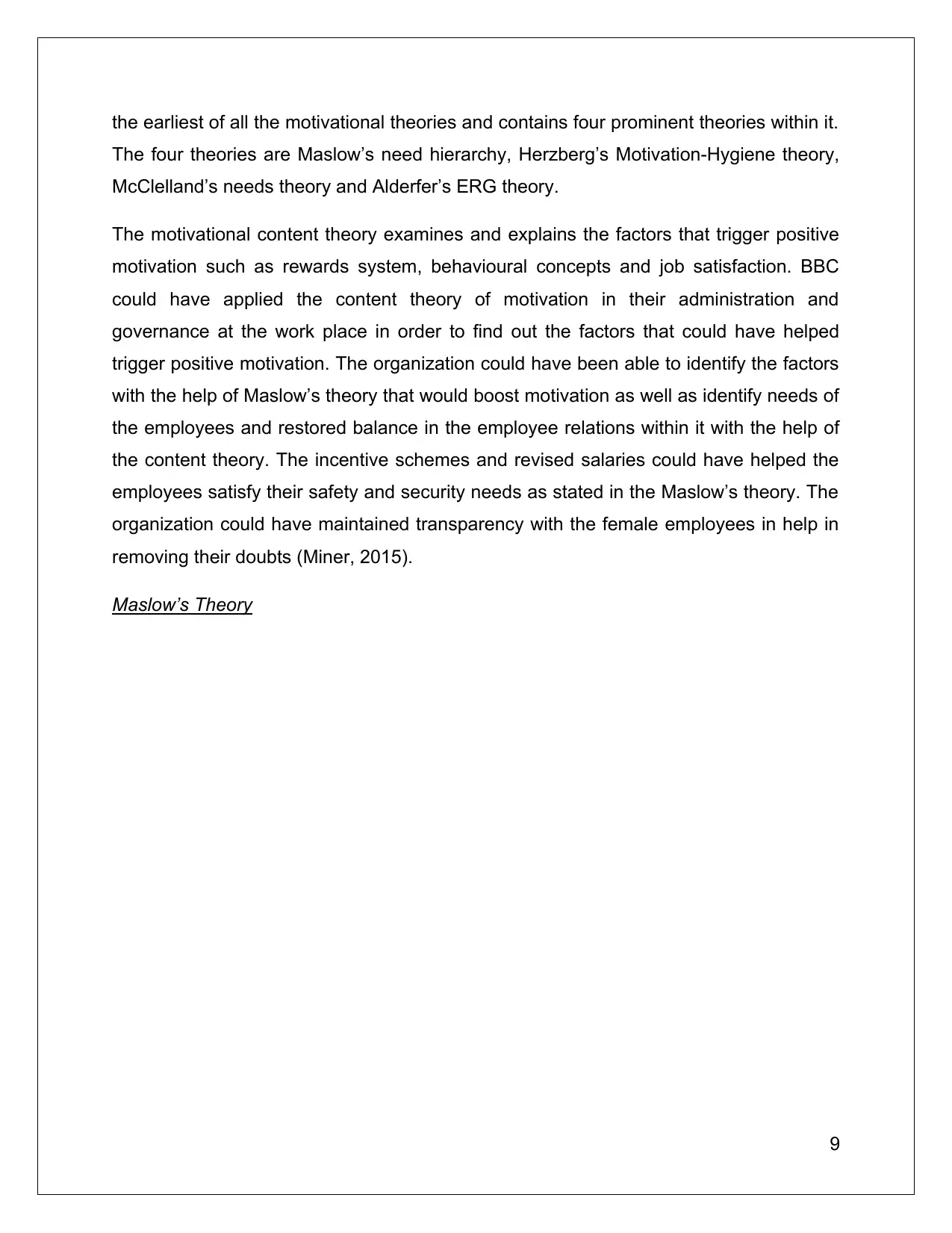
the earliest of all the motivational theories and contains four prominent theories within it.
The four theories are Maslow’s need hierarchy, Herzberg’s Motivation-Hygiene theory,
McClelland’s needs theory and Alderfer’s ERG theory.
The motivational content theory examines and explains the factors that trigger positive
motivation such as rewards system, behavioural concepts and job satisfaction. BBC
could have applied the content theory of motivation in their administration and
governance at the work place in order to find out the factors that could have helped
trigger positive motivation. The organization could have been able to identify the factors
with the help of Maslow’s theory that would boost motivation as well as identify needs of
the employees and restored balance in the employee relations within it with the help of
the content theory. The incentive schemes and revised salaries could have helped the
employees satisfy their safety and security needs as stated in the Maslow’s theory. The
organization could have maintained transparency with the female employees in help in
removing their doubts (Miner, 2015).
Maslow’s Theory
9
The four theories are Maslow’s need hierarchy, Herzberg’s Motivation-Hygiene theory,
McClelland’s needs theory and Alderfer’s ERG theory.
The motivational content theory examines and explains the factors that trigger positive
motivation such as rewards system, behavioural concepts and job satisfaction. BBC
could have applied the content theory of motivation in their administration and
governance at the work place in order to find out the factors that could have helped
trigger positive motivation. The organization could have been able to identify the factors
with the help of Maslow’s theory that would boost motivation as well as identify needs of
the employees and restored balance in the employee relations within it with the help of
the content theory. The incentive schemes and revised salaries could have helped the
employees satisfy their safety and security needs as stated in the Maslow’s theory. The
organization could have maintained transparency with the female employees in help in
removing their doubts (Miner, 2015).
Maslow’s Theory
9
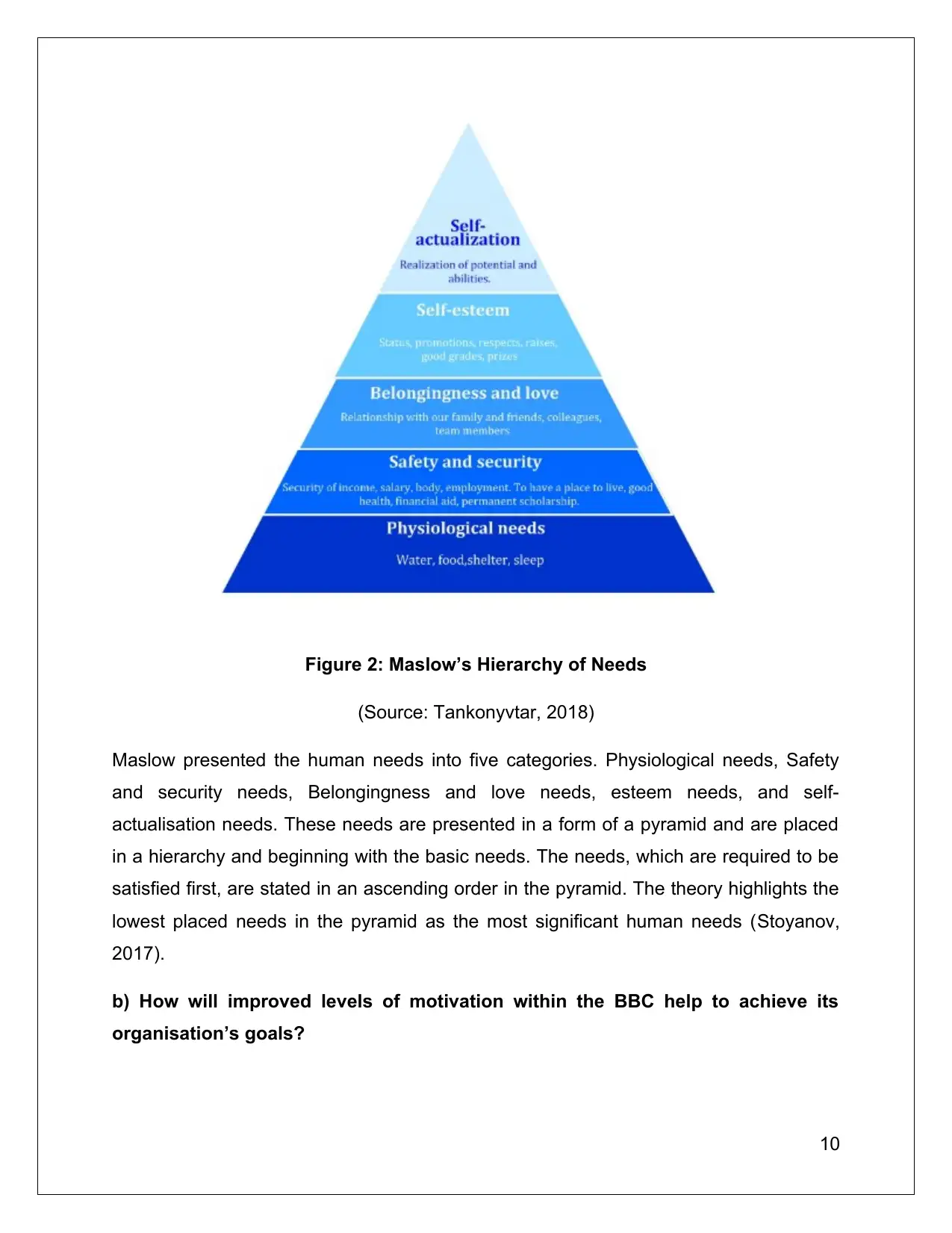
Figure 2: Maslow’s Hierarchy of Needs
(Source: Tankonyvtar, 2018)
Maslow presented the human needs into five categories. Physiological needs, Safety
and security needs, Belongingness and love needs, esteem needs, and self-
actualisation needs. These needs are presented in a form of a pyramid and are placed
in a hierarchy and beginning with the basic needs. The needs, which are required to be
satisfied first, are stated in an ascending order in the pyramid. The theory highlights the
lowest placed needs in the pyramid as the most significant human needs (Stoyanov,
2017).
b) How will improved levels of motivation within the BBC help to achieve its
organisation’s goals?
10
(Source: Tankonyvtar, 2018)
Maslow presented the human needs into five categories. Physiological needs, Safety
and security needs, Belongingness and love needs, esteem needs, and self-
actualisation needs. These needs are presented in a form of a pyramid and are placed
in a hierarchy and beginning with the basic needs. The needs, which are required to be
satisfied first, are stated in an ascending order in the pyramid. The theory highlights the
lowest placed needs in the pyramid as the most significant human needs (Stoyanov,
2017).
b) How will improved levels of motivation within the BBC help to achieve its
organisation’s goals?
10
Secure Best Marks with AI Grader
Need help grading? Try our AI Grader for instant feedback on your assignments.
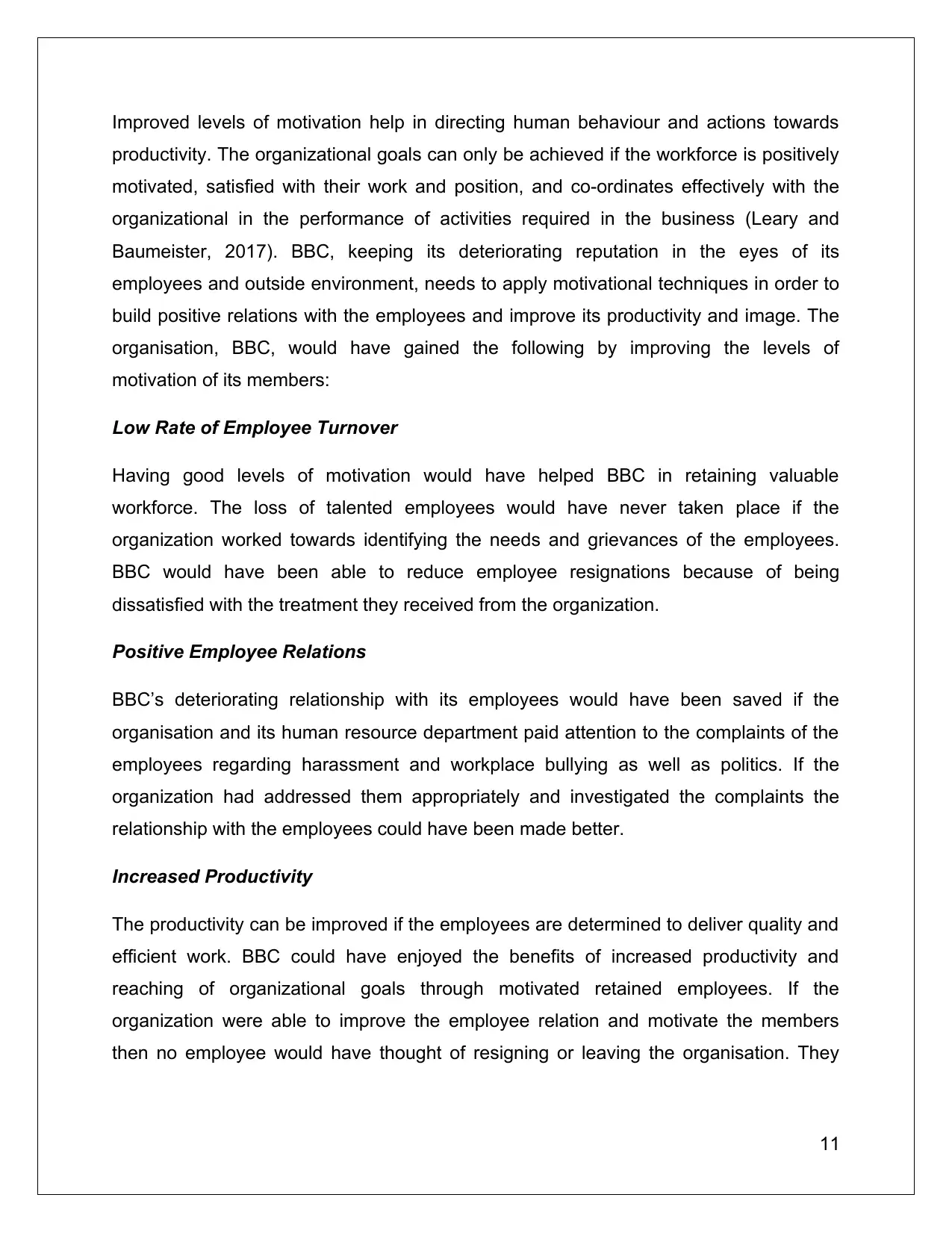
Improved levels of motivation help in directing human behaviour and actions towards
productivity. The organizational goals can only be achieved if the workforce is positively
motivated, satisfied with their work and position, and co-ordinates effectively with the
organizational in the performance of activities required in the business (Leary and
Baumeister, 2017). BBC, keeping its deteriorating reputation in the eyes of its
employees and outside environment, needs to apply motivational techniques in order to
build positive relations with the employees and improve its productivity and image. The
organisation, BBC, would have gained the following by improving the levels of
motivation of its members:
Low Rate of Employee Turnover
Having good levels of motivation would have helped BBC in retaining valuable
workforce. The loss of talented employees would have never taken place if the
organization worked towards identifying the needs and grievances of the employees.
BBC would have been able to reduce employee resignations because of being
dissatisfied with the treatment they received from the organization.
Positive Employee Relations
BBC’s deteriorating relationship with its employees would have been saved if the
organisation and its human resource department paid attention to the complaints of the
employees regarding harassment and workplace bullying as well as politics. If the
organization had addressed them appropriately and investigated the complaints the
relationship with the employees could have been made better.
Increased Productivity
The productivity can be improved if the employees are determined to deliver quality and
efficient work. BBC could have enjoyed the benefits of increased productivity and
reaching of organizational goals through motivated retained employees. If the
organization were able to improve the employee relation and motivate the members
then no employee would have thought of resigning or leaving the organisation. They
11
productivity. The organizational goals can only be achieved if the workforce is positively
motivated, satisfied with their work and position, and co-ordinates effectively with the
organizational in the performance of activities required in the business (Leary and
Baumeister, 2017). BBC, keeping its deteriorating reputation in the eyes of its
employees and outside environment, needs to apply motivational techniques in order to
build positive relations with the employees and improve its productivity and image. The
organisation, BBC, would have gained the following by improving the levels of
motivation of its members:
Low Rate of Employee Turnover
Having good levels of motivation would have helped BBC in retaining valuable
workforce. The loss of talented employees would have never taken place if the
organization worked towards identifying the needs and grievances of the employees.
BBC would have been able to reduce employee resignations because of being
dissatisfied with the treatment they received from the organization.
Positive Employee Relations
BBC’s deteriorating relationship with its employees would have been saved if the
organisation and its human resource department paid attention to the complaints of the
employees regarding harassment and workplace bullying as well as politics. If the
organization had addressed them appropriately and investigated the complaints the
relationship with the employees could have been made better.
Increased Productivity
The productivity can be improved if the employees are determined to deliver quality and
efficient work. BBC could have enjoyed the benefits of increased productivity and
reaching of organizational goals through motivated retained employees. If the
organization were able to improve the employee relation and motivate the members
then no employee would have thought of resigning or leaving the organisation. They
11
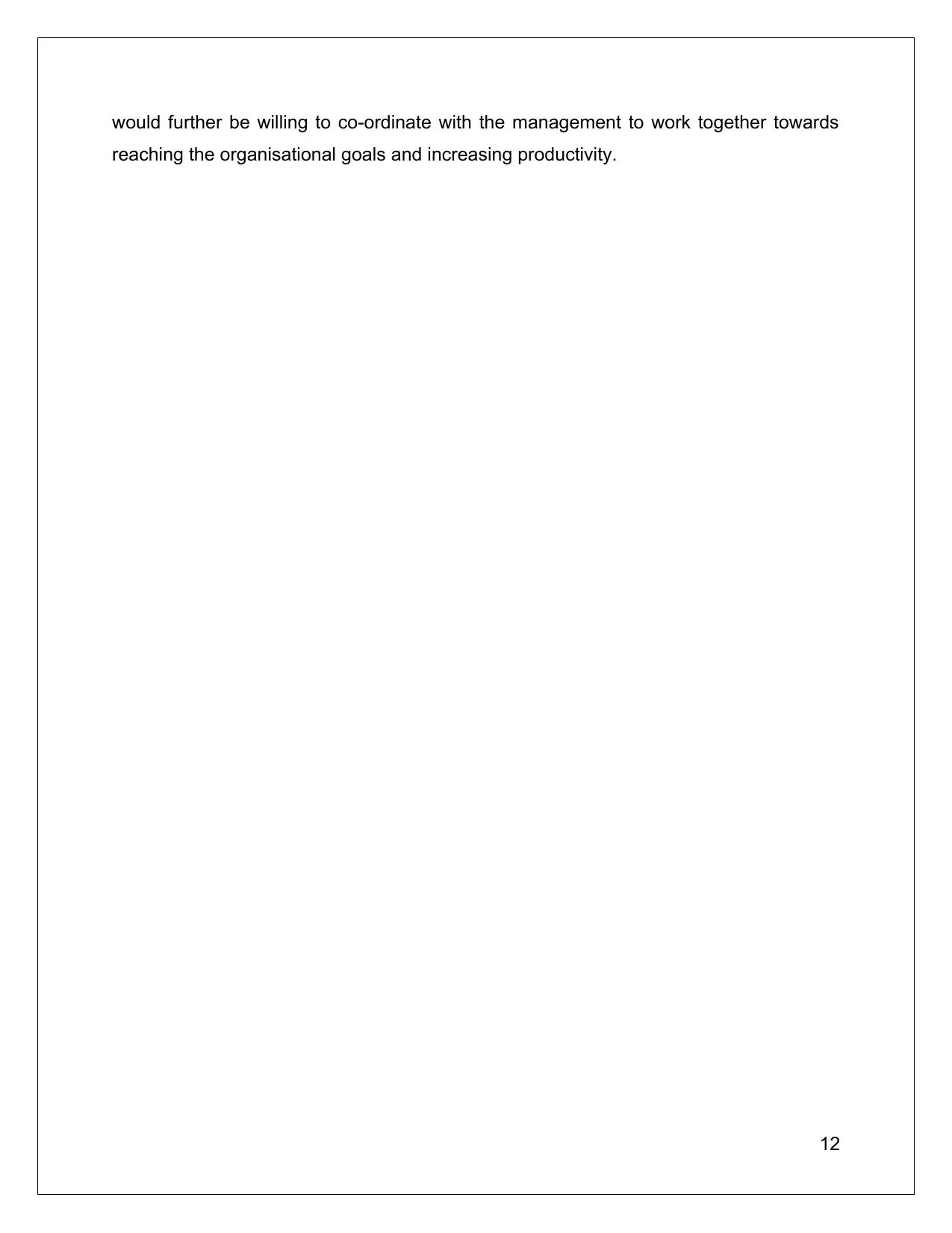
would further be willing to co-ordinate with the management to work together towards
reaching the organisational goals and increasing productivity.
12
reaching the organisational goals and increasing productivity.
12
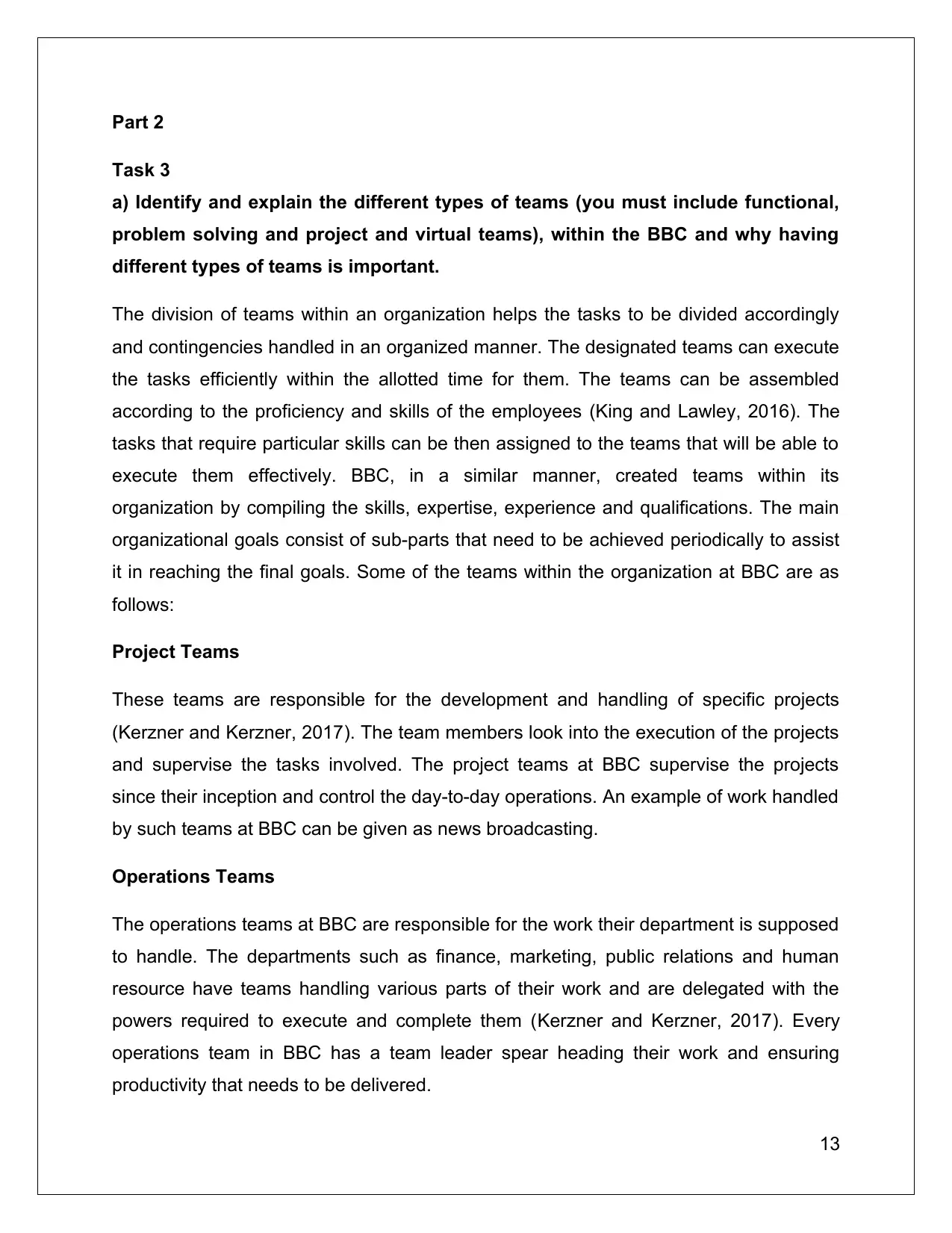
Part 2
Task 3
a) Identify and explain the different types of teams (you must include functional,
problem solving and project and virtual teams), within the BBC and why having
different types of teams is important.
The division of teams within an organization helps the tasks to be divided accordingly
and contingencies handled in an organized manner. The designated teams can execute
the tasks efficiently within the allotted time for them. The teams can be assembled
according to the proficiency and skills of the employees (King and Lawley, 2016). The
tasks that require particular skills can be then assigned to the teams that will be able to
execute them effectively. BBC, in a similar manner, created teams within its
organization by compiling the skills, expertise, experience and qualifications. The main
organizational goals consist of sub-parts that need to be achieved periodically to assist
it in reaching the final goals. Some of the teams within the organization at BBC are as
follows:
Project Teams
These teams are responsible for the development and handling of specific projects
(Kerzner and Kerzner, 2017). The team members look into the execution of the projects
and supervise the tasks involved. The project teams at BBC supervise the projects
since their inception and control the day-to-day operations. An example of work handled
by such teams at BBC can be given as news broadcasting.
Operations Teams
The operations teams at BBC are responsible for the work their department is supposed
to handle. The departments such as finance, marketing, public relations and human
resource have teams handling various parts of their work and are delegated with the
powers required to execute and complete them (Kerzner and Kerzner, 2017). Every
operations team in BBC has a team leader spear heading their work and ensuring
productivity that needs to be delivered.
13
Task 3
a) Identify and explain the different types of teams (you must include functional,
problem solving and project and virtual teams), within the BBC and why having
different types of teams is important.
The division of teams within an organization helps the tasks to be divided accordingly
and contingencies handled in an organized manner. The designated teams can execute
the tasks efficiently within the allotted time for them. The teams can be assembled
according to the proficiency and skills of the employees (King and Lawley, 2016). The
tasks that require particular skills can be then assigned to the teams that will be able to
execute them effectively. BBC, in a similar manner, created teams within its
organization by compiling the skills, expertise, experience and qualifications. The main
organizational goals consist of sub-parts that need to be achieved periodically to assist
it in reaching the final goals. Some of the teams within the organization at BBC are as
follows:
Project Teams
These teams are responsible for the development and handling of specific projects
(Kerzner and Kerzner, 2017). The team members look into the execution of the projects
and supervise the tasks involved. The project teams at BBC supervise the projects
since their inception and control the day-to-day operations. An example of work handled
by such teams at BBC can be given as news broadcasting.
Operations Teams
The operations teams at BBC are responsible for the work their department is supposed
to handle. The departments such as finance, marketing, public relations and human
resource have teams handling various parts of their work and are delegated with the
powers required to execute and complete them (Kerzner and Kerzner, 2017). Every
operations team in BBC has a team leader spear heading their work and ensuring
productivity that needs to be delivered.
13
Paraphrase This Document
Need a fresh take? Get an instant paraphrase of this document with our AI Paraphraser
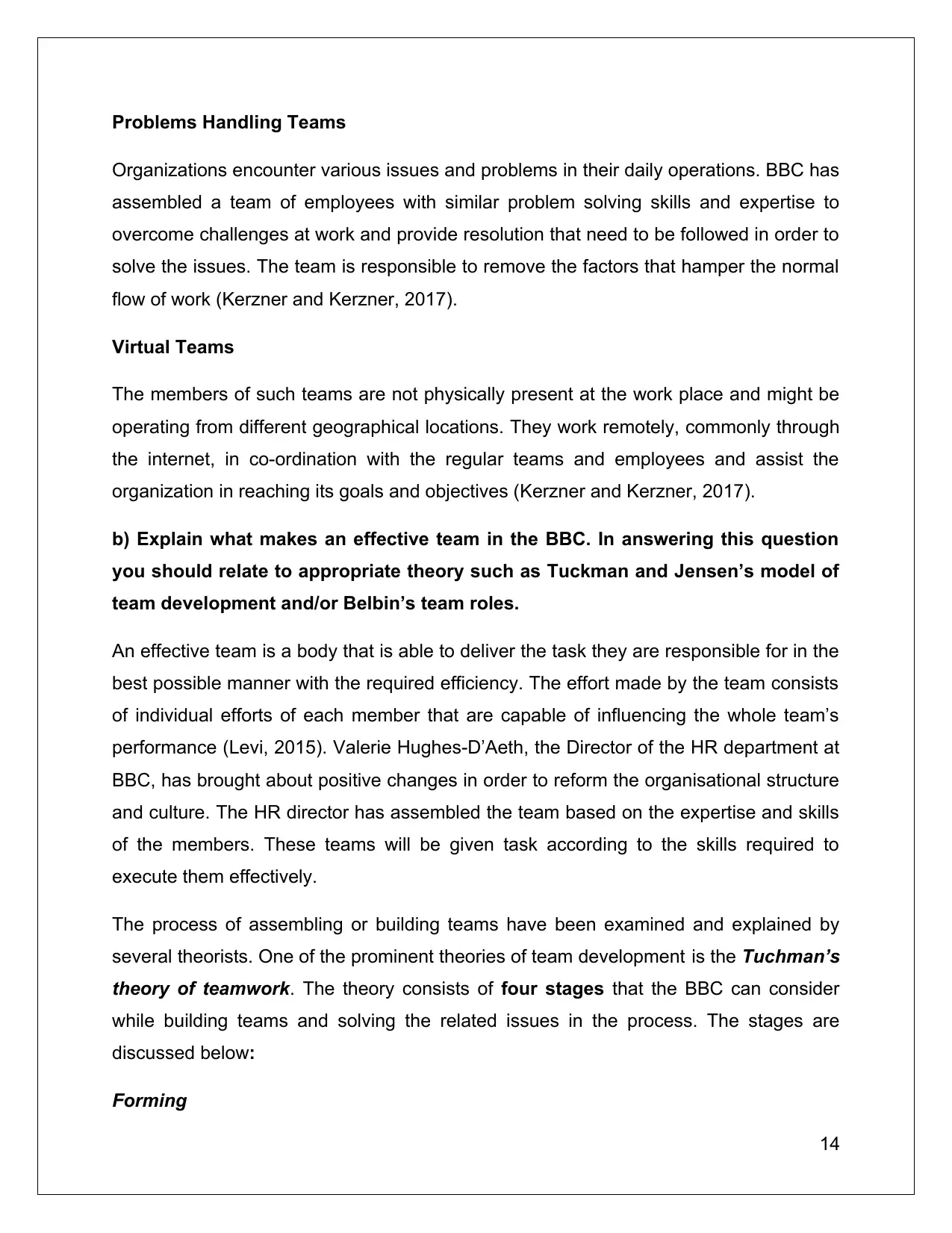
Problems Handling Teams
Organizations encounter various issues and problems in their daily operations. BBC has
assembled a team of employees with similar problem solving skills and expertise to
overcome challenges at work and provide resolution that need to be followed in order to
solve the issues. The team is responsible to remove the factors that hamper the normal
flow of work (Kerzner and Kerzner, 2017).
Virtual Teams
The members of such teams are not physically present at the work place and might be
operating from different geographical locations. They work remotely, commonly through
the internet, in co-ordination with the regular teams and employees and assist the
organization in reaching its goals and objectives (Kerzner and Kerzner, 2017).
b) Explain what makes an effective team in the BBC. In answering this question
you should relate to appropriate theory such as Tuckman and Jensen’s model of
team development and/or Belbin’s team roles.
An effective team is a body that is able to deliver the task they are responsible for in the
best possible manner with the required efficiency. The effort made by the team consists
of individual efforts of each member that are capable of influencing the whole team’s
performance (Levi, 2015). Valerie Hughes-D’Aeth, the Director of the HR department at
BBC, has brought about positive changes in order to reform the organisational structure
and culture. The HR director has assembled the team based on the expertise and skills
of the members. These teams will be given task according to the skills required to
execute them effectively.
The process of assembling or building teams have been examined and explained by
several theorists. One of the prominent theories of team development is the Tuchman’s
theory of teamwork. The theory consists of four stages that the BBC can consider
while building teams and solving the related issues in the process. The stages are
discussed below:
Forming
14
Organizations encounter various issues and problems in their daily operations. BBC has
assembled a team of employees with similar problem solving skills and expertise to
overcome challenges at work and provide resolution that need to be followed in order to
solve the issues. The team is responsible to remove the factors that hamper the normal
flow of work (Kerzner and Kerzner, 2017).
Virtual Teams
The members of such teams are not physically present at the work place and might be
operating from different geographical locations. They work remotely, commonly through
the internet, in co-ordination with the regular teams and employees and assist the
organization in reaching its goals and objectives (Kerzner and Kerzner, 2017).
b) Explain what makes an effective team in the BBC. In answering this question
you should relate to appropriate theory such as Tuckman and Jensen’s model of
team development and/or Belbin’s team roles.
An effective team is a body that is able to deliver the task they are responsible for in the
best possible manner with the required efficiency. The effort made by the team consists
of individual efforts of each member that are capable of influencing the whole team’s
performance (Levi, 2015). Valerie Hughes-D’Aeth, the Director of the HR department at
BBC, has brought about positive changes in order to reform the organisational structure
and culture. The HR director has assembled the team based on the expertise and skills
of the members. These teams will be given task according to the skills required to
execute them effectively.
The process of assembling or building teams have been examined and explained by
several theorists. One of the prominent theories of team development is the Tuchman’s
theory of teamwork. The theory consists of four stages that the BBC can consider
while building teams and solving the related issues in the process. The stages are
discussed below:
Forming
14
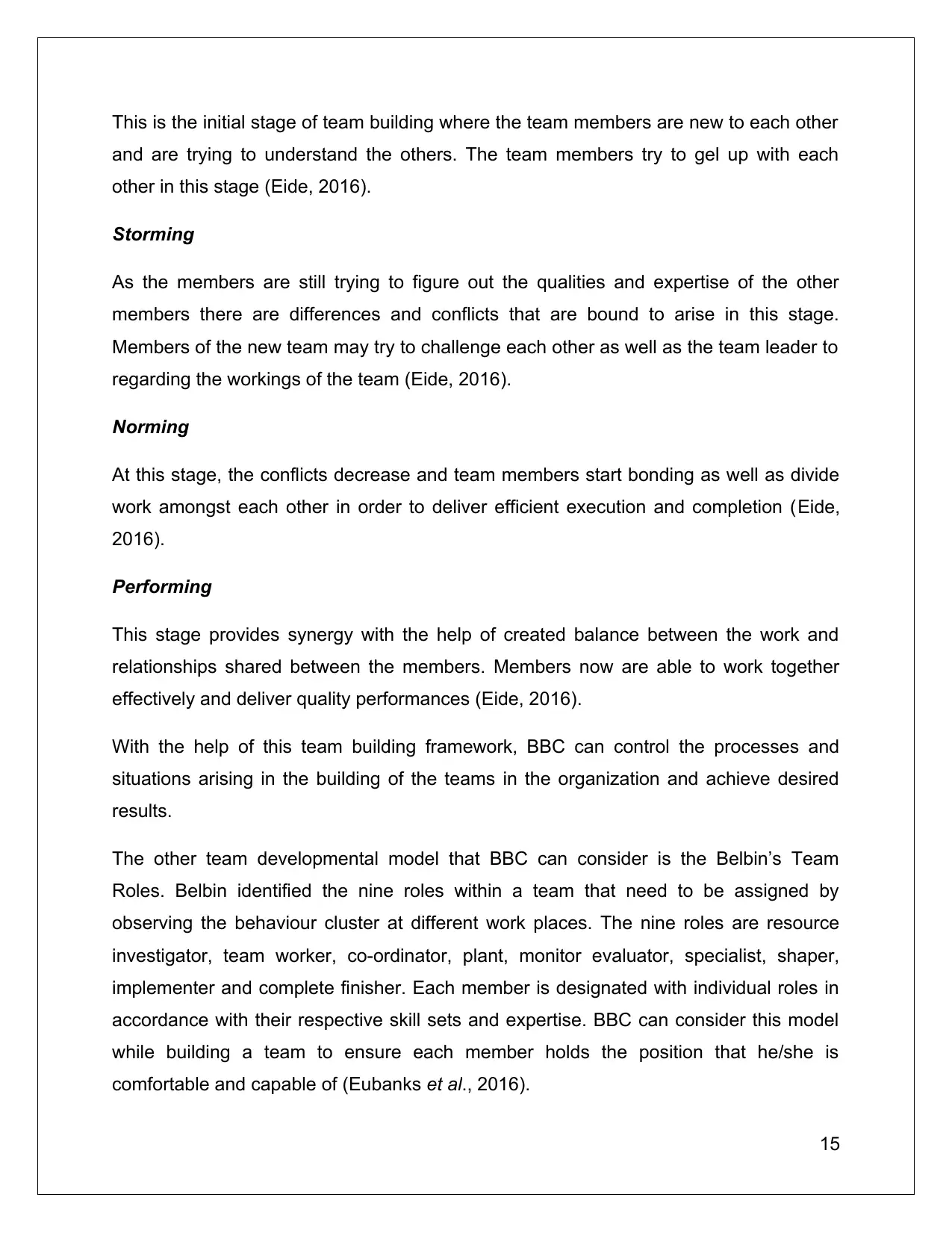
This is the initial stage of team building where the team members are new to each other
and are trying to understand the others. The team members try to gel up with each
other in this stage (Eide, 2016).
Storming
As the members are still trying to figure out the qualities and expertise of the other
members there are differences and conflicts that are bound to arise in this stage.
Members of the new team may try to challenge each other as well as the team leader to
regarding the workings of the team (Eide, 2016).
Norming
At this stage, the conflicts decrease and team members start bonding as well as divide
work amongst each other in order to deliver efficient execution and completion (Eide,
2016).
Performing
This stage provides synergy with the help of created balance between the work and
relationships shared between the members. Members now are able to work together
effectively and deliver quality performances (Eide, 2016).
With the help of this team building framework, BBC can control the processes and
situations arising in the building of the teams in the organization and achieve desired
results.
The other team developmental model that BBC can consider is the Belbin’s Team
Roles. Belbin identified the nine roles within a team that need to be assigned by
observing the behaviour cluster at different work places. The nine roles are resource
investigator, team worker, co-ordinator, plant, monitor evaluator, specialist, shaper,
implementer and complete finisher. Each member is designated with individual roles in
accordance with their respective skill sets and expertise. BBC can consider this model
while building a team to ensure each member holds the position that he/she is
comfortable and capable of (Eubanks et al., 2016).
15
and are trying to understand the others. The team members try to gel up with each
other in this stage (Eide, 2016).
Storming
As the members are still trying to figure out the qualities and expertise of the other
members there are differences and conflicts that are bound to arise in this stage.
Members of the new team may try to challenge each other as well as the team leader to
regarding the workings of the team (Eide, 2016).
Norming
At this stage, the conflicts decrease and team members start bonding as well as divide
work amongst each other in order to deliver efficient execution and completion (Eide,
2016).
Performing
This stage provides synergy with the help of created balance between the work and
relationships shared between the members. Members now are able to work together
effectively and deliver quality performances (Eide, 2016).
With the help of this team building framework, BBC can control the processes and
situations arising in the building of the teams in the organization and achieve desired
results.
The other team developmental model that BBC can consider is the Belbin’s Team
Roles. Belbin identified the nine roles within a team that need to be assigned by
observing the behaviour cluster at different work places. The nine roles are resource
investigator, team worker, co-ordinator, plant, monitor evaluator, specialist, shaper,
implementer and complete finisher. Each member is designated with individual roles in
accordance with their respective skill sets and expertise. BBC can consider this model
while building a team to ensure each member holds the position that he/she is
comfortable and capable of (Eubanks et al., 2016).
15
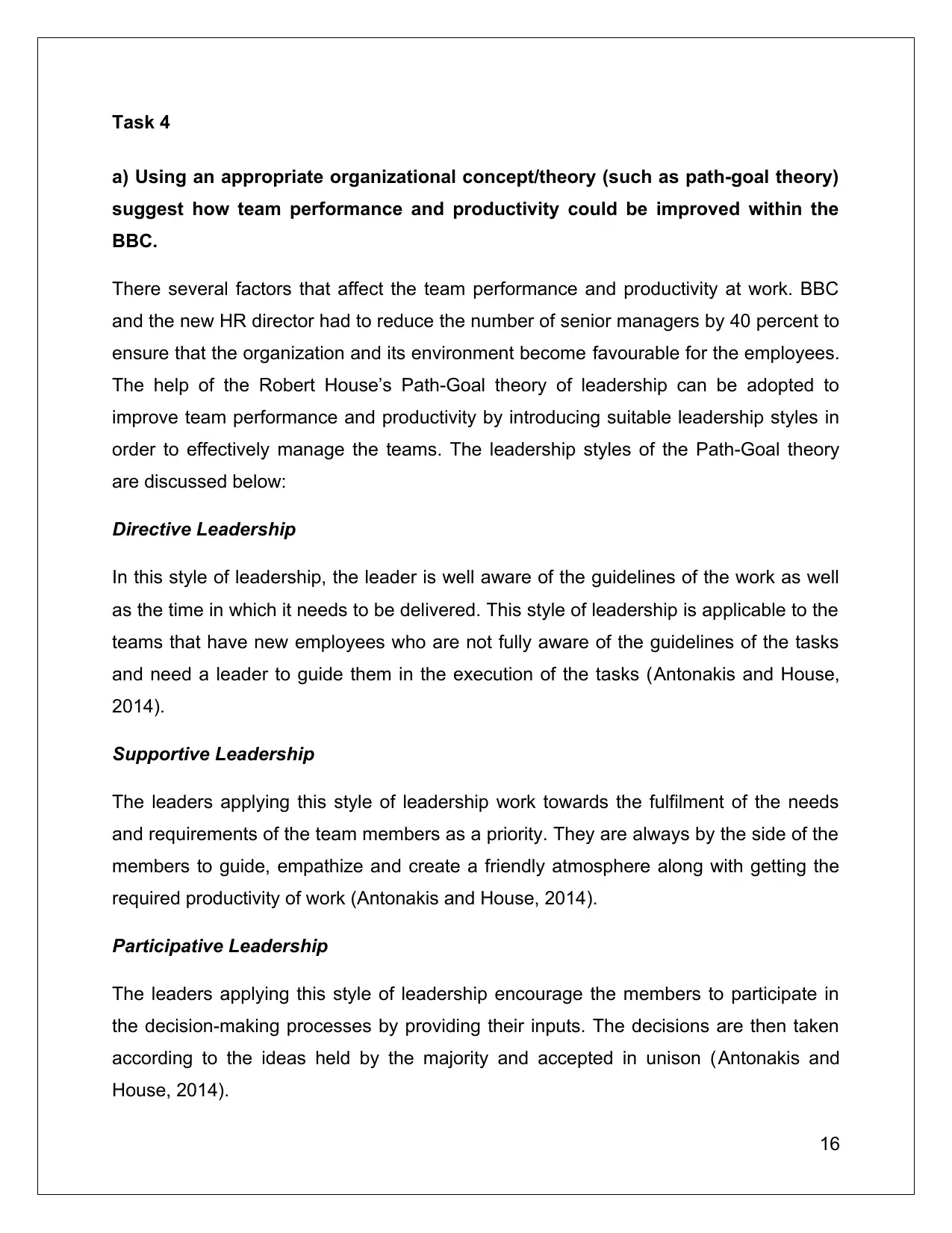
Task 4
a) Using an appropriate organizational concept/theory (such as path-goal theory)
suggest how team performance and productivity could be improved within the
BBC.
There several factors that affect the team performance and productivity at work. BBC
and the new HR director had to reduce the number of senior managers by 40 percent to
ensure that the organization and its environment become favourable for the employees.
The help of the Robert House’s Path-Goal theory of leadership can be adopted to
improve team performance and productivity by introducing suitable leadership styles in
order to effectively manage the teams. The leadership styles of the Path-Goal theory
are discussed below:
Directive Leadership
In this style of leadership, the leader is well aware of the guidelines of the work as well
as the time in which it needs to be delivered. This style of leadership is applicable to the
teams that have new employees who are not fully aware of the guidelines of the tasks
and need a leader to guide them in the execution of the tasks (Antonakis and House,
2014).
Supportive Leadership
The leaders applying this style of leadership work towards the fulfilment of the needs
and requirements of the team members as a priority. They are always by the side of the
members to guide, empathize and create a friendly atmosphere along with getting the
required productivity of work (Antonakis and House, 2014).
Participative Leadership
The leaders applying this style of leadership encourage the members to participate in
the decision-making processes by providing their inputs. The decisions are then taken
according to the ideas held by the majority and accepted in unison (Antonakis and
House, 2014).
16
a) Using an appropriate organizational concept/theory (such as path-goal theory)
suggest how team performance and productivity could be improved within the
BBC.
There several factors that affect the team performance and productivity at work. BBC
and the new HR director had to reduce the number of senior managers by 40 percent to
ensure that the organization and its environment become favourable for the employees.
The help of the Robert House’s Path-Goal theory of leadership can be adopted to
improve team performance and productivity by introducing suitable leadership styles in
order to effectively manage the teams. The leadership styles of the Path-Goal theory
are discussed below:
Directive Leadership
In this style of leadership, the leader is well aware of the guidelines of the work as well
as the time in which it needs to be delivered. This style of leadership is applicable to the
teams that have new employees who are not fully aware of the guidelines of the tasks
and need a leader to guide them in the execution of the tasks (Antonakis and House,
2014).
Supportive Leadership
The leaders applying this style of leadership work towards the fulfilment of the needs
and requirements of the team members as a priority. They are always by the side of the
members to guide, empathize and create a friendly atmosphere along with getting the
required productivity of work (Antonakis and House, 2014).
Participative Leadership
The leaders applying this style of leadership encourage the members to participate in
the decision-making processes by providing their inputs. The decisions are then taken
according to the ideas held by the majority and accepted in unison (Antonakis and
House, 2014).
16
Secure Best Marks with AI Grader
Need help grading? Try our AI Grader for instant feedback on your assignments.
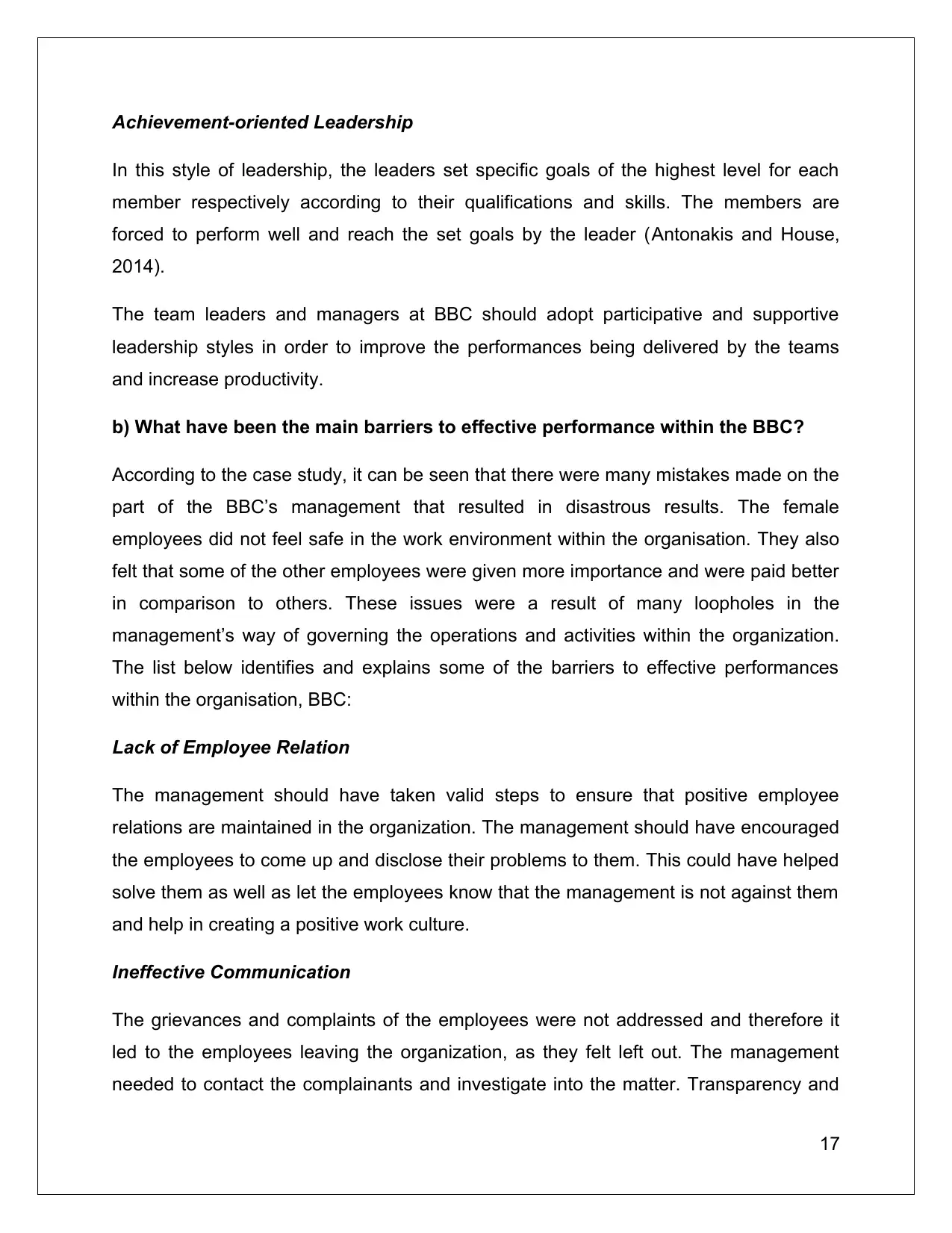
Achievement-oriented Leadership
In this style of leadership, the leaders set specific goals of the highest level for each
member respectively according to their qualifications and skills. The members are
forced to perform well and reach the set goals by the leader (Antonakis and House,
2014).
The team leaders and managers at BBC should adopt participative and supportive
leadership styles in order to improve the performances being delivered by the teams
and increase productivity.
b) What have been the main barriers to effective performance within the BBC?
According to the case study, it can be seen that there were many mistakes made on the
part of the BBC’s management that resulted in disastrous results. The female
employees did not feel safe in the work environment within the organisation. They also
felt that some of the other employees were given more importance and were paid better
in comparison to others. These issues were a result of many loopholes in the
management’s way of governing the operations and activities within the organization.
The list below identifies and explains some of the barriers to effective performances
within the organisation, BBC:
Lack of Employee Relation
The management should have taken valid steps to ensure that positive employee
relations are maintained in the organization. The management should have encouraged
the employees to come up and disclose their problems to them. This could have helped
solve them as well as let the employees know that the management is not against them
and help in creating a positive work culture.
Ineffective Communication
The grievances and complaints of the employees were not addressed and therefore it
led to the employees leaving the organization, as they felt left out. The management
needed to contact the complainants and investigate into the matter. Transparency and
17
In this style of leadership, the leaders set specific goals of the highest level for each
member respectively according to their qualifications and skills. The members are
forced to perform well and reach the set goals by the leader (Antonakis and House,
2014).
The team leaders and managers at BBC should adopt participative and supportive
leadership styles in order to improve the performances being delivered by the teams
and increase productivity.
b) What have been the main barriers to effective performance within the BBC?
According to the case study, it can be seen that there were many mistakes made on the
part of the BBC’s management that resulted in disastrous results. The female
employees did not feel safe in the work environment within the organisation. They also
felt that some of the other employees were given more importance and were paid better
in comparison to others. These issues were a result of many loopholes in the
management’s way of governing the operations and activities within the organization.
The list below identifies and explains some of the barriers to effective performances
within the organisation, BBC:
Lack of Employee Relation
The management should have taken valid steps to ensure that positive employee
relations are maintained in the organization. The management should have encouraged
the employees to come up and disclose their problems to them. This could have helped
solve them as well as let the employees know that the management is not against them
and help in creating a positive work culture.
Ineffective Communication
The grievances and complaints of the employees were not addressed and therefore it
led to the employees leaving the organization, as they felt left out. The management
needed to contact the complainants and investigate into the matter. Transparency and
17
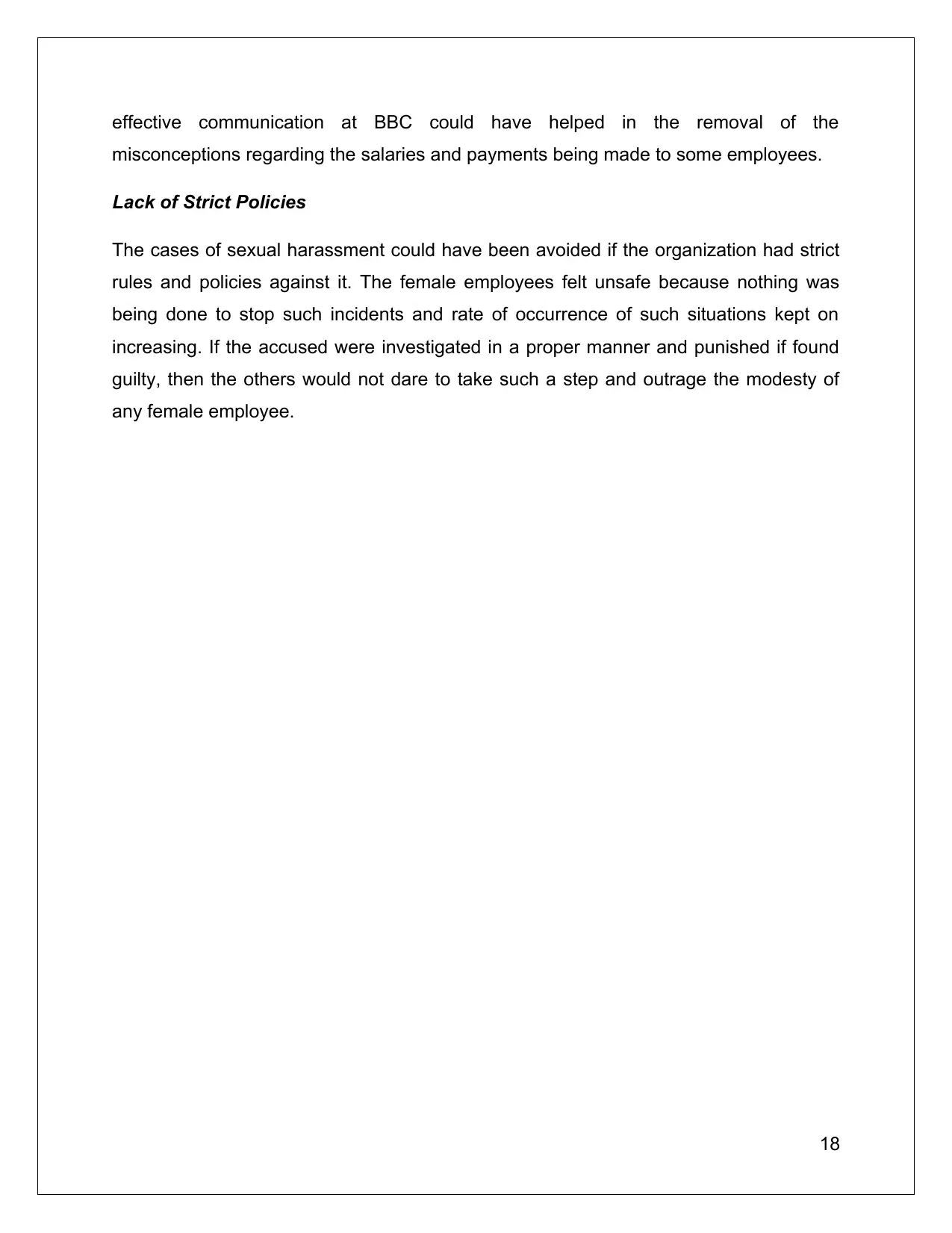
effective communication at BBC could have helped in the removal of the
misconceptions regarding the salaries and payments being made to some employees.
Lack of Strict Policies
The cases of sexual harassment could have been avoided if the organization had strict
rules and policies against it. The female employees felt unsafe because nothing was
being done to stop such incidents and rate of occurrence of such situations kept on
increasing. If the accused were investigated in a proper manner and punished if found
guilty, then the others would not dare to take such a step and outrage the modesty of
any female employee.
18
misconceptions regarding the salaries and payments being made to some employees.
Lack of Strict Policies
The cases of sexual harassment could have been avoided if the organization had strict
rules and policies against it. The female employees felt unsafe because nothing was
being done to stop such incidents and rate of occurrence of such situations kept on
increasing. If the accused were investigated in a proper manner and punished if found
guilty, then the others would not dare to take such a step and outrage the modesty of
any female employee.
18
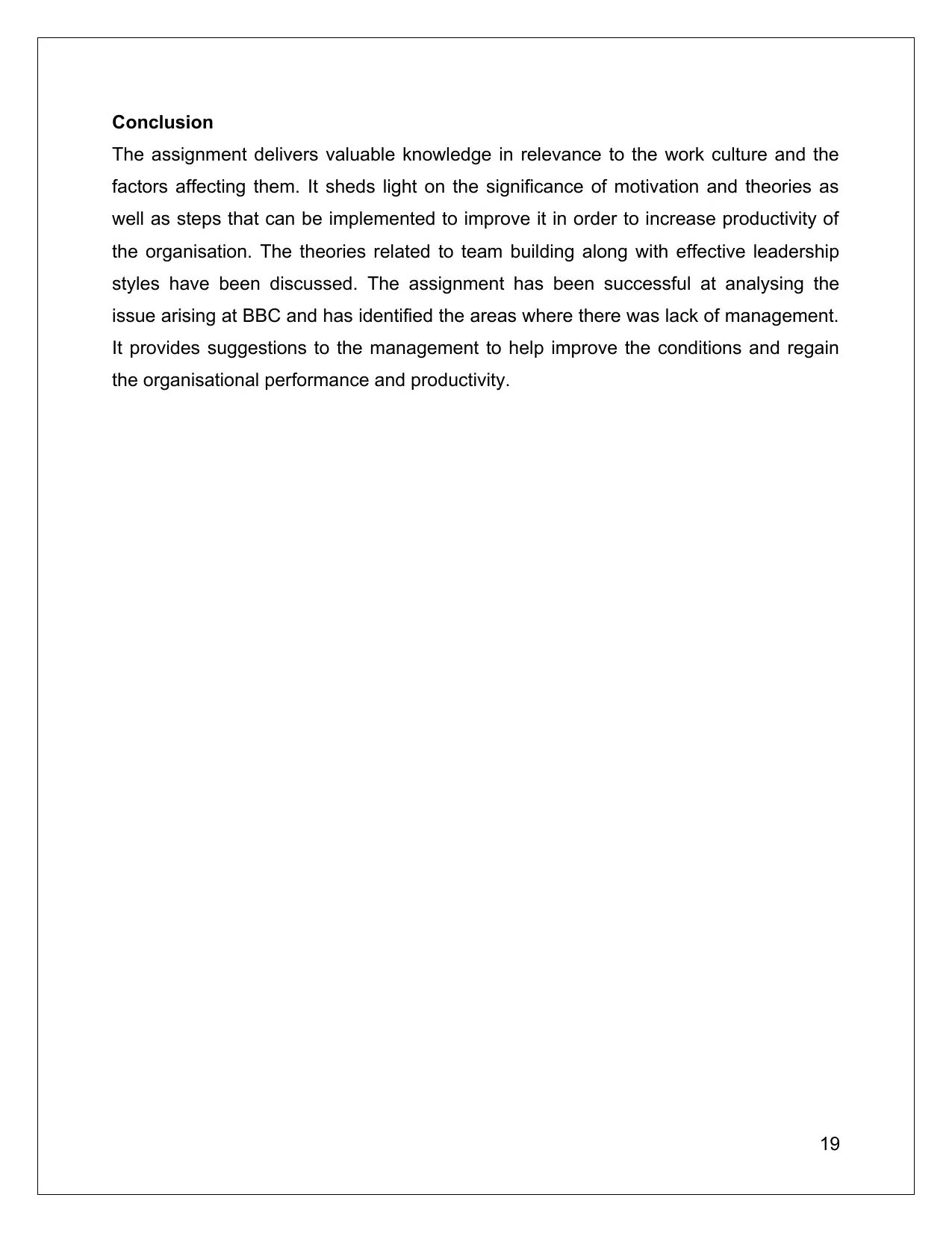
Conclusion
The assignment delivers valuable knowledge in relevance to the work culture and the
factors affecting them. It sheds light on the significance of motivation and theories as
well as steps that can be implemented to improve it in order to increase productivity of
the organisation. The theories related to team building along with effective leadership
styles have been discussed. The assignment has been successful at analysing the
issue arising at BBC and has identified the areas where there was lack of management.
It provides suggestions to the management to help improve the conditions and regain
the organisational performance and productivity.
19
The assignment delivers valuable knowledge in relevance to the work culture and the
factors affecting them. It sheds light on the significance of motivation and theories as
well as steps that can be implemented to improve it in order to increase productivity of
the organisation. The theories related to team building along with effective leadership
styles have been discussed. The assignment has been successful at analysing the
issue arising at BBC and has identified the areas where there was lack of management.
It provides suggestions to the management to help improve the conditions and regain
the organisational performance and productivity.
19
Paraphrase This Document
Need a fresh take? Get an instant paraphrase of this document with our AI Paraphraser
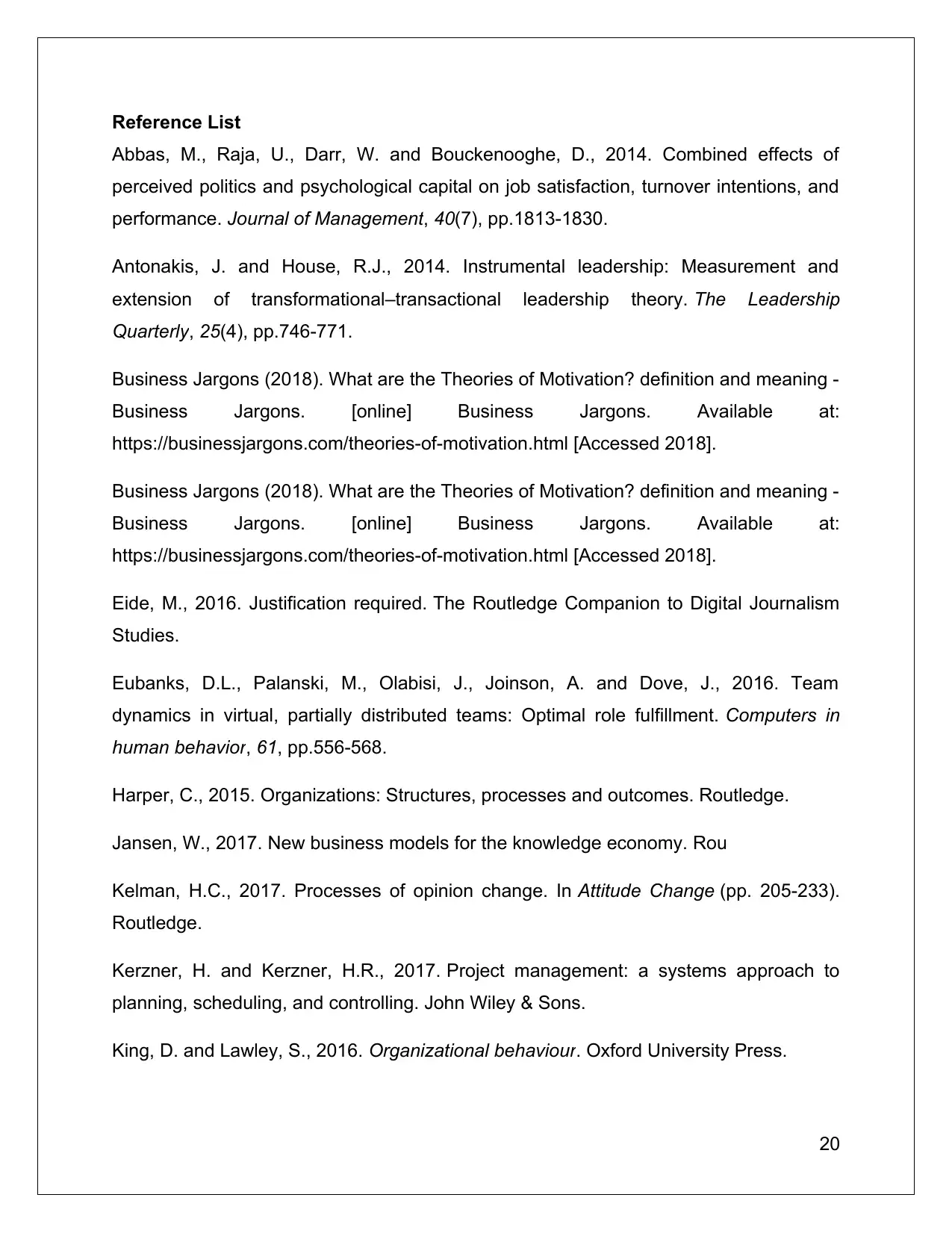
Reference List
Abbas, M., Raja, U., Darr, W. and Bouckenooghe, D., 2014. Combined effects of
perceived politics and psychological capital on job satisfaction, turnover intentions, and
performance. Journal of Management, 40(7), pp.1813-1830.
Antonakis, J. and House, R.J., 2014. Instrumental leadership: Measurement and
extension of transformational–transactional leadership theory. The Leadership
Quarterly, 25(4), pp.746-771.
Business Jargons (2018). What are the Theories of Motivation? definition and meaning -
Business Jargons. [online] Business Jargons. Available at:
https://businessjargons.com/theories-of-motivation.html [Accessed 2018].
Business Jargons (2018). What are the Theories of Motivation? definition and meaning -
Business Jargons. [online] Business Jargons. Available at:
https://businessjargons.com/theories-of-motivation.html [Accessed 2018].
Eide, M., 2016. Justification required. The Routledge Companion to Digital Journalism
Studies.
Eubanks, D.L., Palanski, M., Olabisi, J., Joinson, A. and Dove, J., 2016. Team
dynamics in virtual, partially distributed teams: Optimal role fulfillment. Computers in
human behavior, 61, pp.556-568.
Harper, C., 2015. Organizations: Structures, processes and outcomes. Routledge.
Jansen, W., 2017. New business models for the knowledge economy. Rou
Kelman, H.C., 2017. Processes of opinion change. In Attitude Change (pp. 205-233).
Routledge.
Kerzner, H. and Kerzner, H.R., 2017. Project management: a systems approach to
planning, scheduling, and controlling. John Wiley & Sons.
King, D. and Lawley, S., 2016. Organizational behaviour. Oxford University Press.
20
Abbas, M., Raja, U., Darr, W. and Bouckenooghe, D., 2014. Combined effects of
perceived politics and psychological capital on job satisfaction, turnover intentions, and
performance. Journal of Management, 40(7), pp.1813-1830.
Antonakis, J. and House, R.J., 2014. Instrumental leadership: Measurement and
extension of transformational–transactional leadership theory. The Leadership
Quarterly, 25(4), pp.746-771.
Business Jargons (2018). What are the Theories of Motivation? definition and meaning -
Business Jargons. [online] Business Jargons. Available at:
https://businessjargons.com/theories-of-motivation.html [Accessed 2018].
Business Jargons (2018). What are the Theories of Motivation? definition and meaning -
Business Jargons. [online] Business Jargons. Available at:
https://businessjargons.com/theories-of-motivation.html [Accessed 2018].
Eide, M., 2016. Justification required. The Routledge Companion to Digital Journalism
Studies.
Eubanks, D.L., Palanski, M., Olabisi, J., Joinson, A. and Dove, J., 2016. Team
dynamics in virtual, partially distributed teams: Optimal role fulfillment. Computers in
human behavior, 61, pp.556-568.
Harper, C., 2015. Organizations: Structures, processes and outcomes. Routledge.
Jansen, W., 2017. New business models for the knowledge economy. Rou
Kelman, H.C., 2017. Processes of opinion change. In Attitude Change (pp. 205-233).
Routledge.
Kerzner, H. and Kerzner, H.R., 2017. Project management: a systems approach to
planning, scheduling, and controlling. John Wiley & Sons.
King, D. and Lawley, S., 2016. Organizational behaviour. Oxford University Press.
20
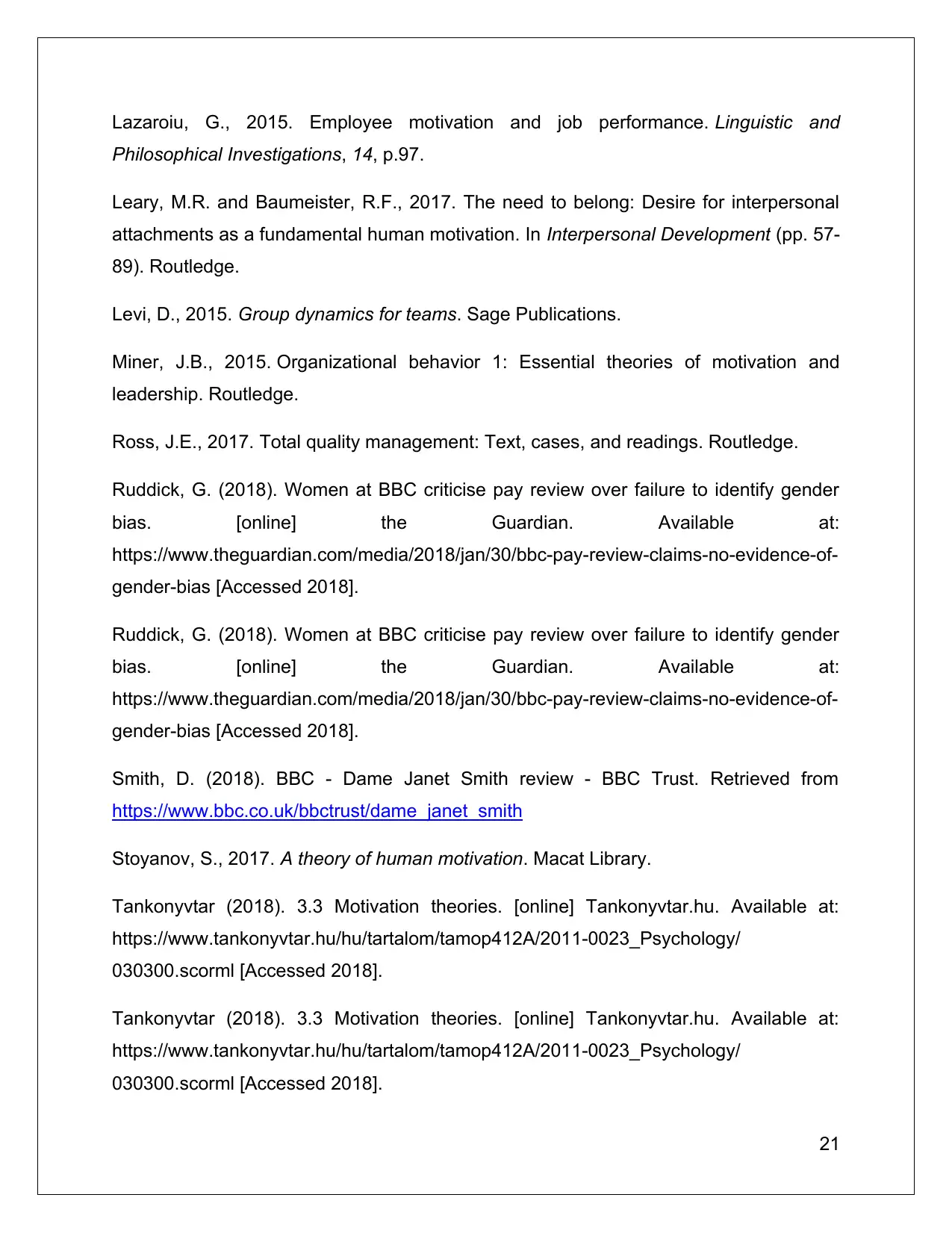
Lazaroiu, G., 2015. Employee motivation and job performance. Linguistic and
Philosophical Investigations, 14, p.97.
Leary, M.R. and Baumeister, R.F., 2017. The need to belong: Desire for interpersonal
attachments as a fundamental human motivation. In Interpersonal Development (pp. 57-
89). Routledge.
Levi, D., 2015. Group dynamics for teams. Sage Publications.
Miner, J.B., 2015. Organizational behavior 1: Essential theories of motivation and
leadership. Routledge.
Ross, J.E., 2017. Total quality management: Text, cases, and readings. Routledge.
Ruddick, G. (2018). Women at BBC criticise pay review over failure to identify gender
bias. [online] the Guardian. Available at:
https://www.theguardian.com/media/2018/jan/30/bbc-pay-review-claims-no-evidence-of-
gender-bias [Accessed 2018].
Ruddick, G. (2018). Women at BBC criticise pay review over failure to identify gender
bias. [online] the Guardian. Available at:
https://www.theguardian.com/media/2018/jan/30/bbc-pay-review-claims-no-evidence-of-
gender-bias [Accessed 2018].
Smith, D. (2018). BBC - Dame Janet Smith review - BBC Trust. Retrieved from
https://www.bbc.co.uk/bbctrust/dame_janet_smith
Stoyanov, S., 2017. A theory of human motivation. Macat Library.
Tankonyvtar (2018). 3.3 Motivation theories. [online] Tankonyvtar.hu. Available at:
https://www.tankonyvtar.hu/hu/tartalom/tamop412A/2011-0023_Psychology/
030300.scorml [Accessed 2018].
Tankonyvtar (2018). 3.3 Motivation theories. [online] Tankonyvtar.hu. Available at:
https://www.tankonyvtar.hu/hu/tartalom/tamop412A/2011-0023_Psychology/
030300.scorml [Accessed 2018].
21
Philosophical Investigations, 14, p.97.
Leary, M.R. and Baumeister, R.F., 2017. The need to belong: Desire for interpersonal
attachments as a fundamental human motivation. In Interpersonal Development (pp. 57-
89). Routledge.
Levi, D., 2015. Group dynamics for teams. Sage Publications.
Miner, J.B., 2015. Organizational behavior 1: Essential theories of motivation and
leadership. Routledge.
Ross, J.E., 2017. Total quality management: Text, cases, and readings. Routledge.
Ruddick, G. (2018). Women at BBC criticise pay review over failure to identify gender
bias. [online] the Guardian. Available at:
https://www.theguardian.com/media/2018/jan/30/bbc-pay-review-claims-no-evidence-of-
gender-bias [Accessed 2018].
Ruddick, G. (2018). Women at BBC criticise pay review over failure to identify gender
bias. [online] the Guardian. Available at:
https://www.theguardian.com/media/2018/jan/30/bbc-pay-review-claims-no-evidence-of-
gender-bias [Accessed 2018].
Smith, D. (2018). BBC - Dame Janet Smith review - BBC Trust. Retrieved from
https://www.bbc.co.uk/bbctrust/dame_janet_smith
Stoyanov, S., 2017. A theory of human motivation. Macat Library.
Tankonyvtar (2018). 3.3 Motivation theories. [online] Tankonyvtar.hu. Available at:
https://www.tankonyvtar.hu/hu/tartalom/tamop412A/2011-0023_Psychology/
030300.scorml [Accessed 2018].
Tankonyvtar (2018). 3.3 Motivation theories. [online] Tankonyvtar.hu. Available at:
https://www.tankonyvtar.hu/hu/tartalom/tamop412A/2011-0023_Psychology/
030300.scorml [Accessed 2018].
21

22
1 out of 22
Related Documents
Your All-in-One AI-Powered Toolkit for Academic Success.
+13062052269
info@desklib.com
Available 24*7 on WhatsApp / Email
![[object Object]](/_next/static/media/star-bottom.7253800d.svg)
Unlock your academic potential
© 2024 | Zucol Services PVT LTD | All rights reserved.





